Student Good Guide
The best UK online resource for students

User Experience Design Personal Statement Example
Find below the User Experience design personal statement that you can use for inspiration. Writing UX design personal statement can be a challenge since there are not many User Experience Design personal statement examples on the blogs to use as a guide when writing your application for university and UCAS .
User Experience Design Personal Statement
Ever since my first Design and Technology class in secondary school, I have been fascinated by the creative process of designing solutions for real-world problems. My passion for user experience design has only grown through my A-level studies in Design Technology, Business , and Physics. I believe the User Experience Design BSc program me at your university is the perfect next step to pursue my interests in an interdisciplinary field that combines design, technology, and human needs.
Beyond the classroom, I have sought opportunities to strengthen my practical skills and gain hands-on experience with design projects. As an avid bike rider, I designed and built my half-pipe ramp in my backyard, which taught me invaluable lessons in working with different materials and structural engineering. More recently, I have been sketching designs for a studio/summer house using recycled materials like wooden pallets. Through these self-initiated projects, I have developed a knack for resourceful problem-solving using whatever materials are available. I aim to continue challenging myself with more complex builds, as I find great satisfaction in creating useful products and spaces from scratch.
I have also worked to improve my technical abilities in sketching, rendering, and digital prototyping. I have been practising sketching and using graphic design software like Google Sketchup to portray my ideas. At school, I received a certificate for achieving one of the highest scores in A-level Design and Technology, demonstrating my passion and aptitude for the subject. The opportunity to learn new design and prototyping software at university excites me, as I believe these tools will be invaluable for my future career.
Beyond design, I am an active, sociable, and versatile person. Team sports like water polo have taught me the importance of collaboration, communication, and flexibility. My other interests include skiing, scuba diving, and going to the gym, as I value an active and balanced lifestyle. I believe my mix of creative, technical, and interpersonal abilities would allow me to thrive in the multidisciplinary environment of your User Experience Design programme and any professional role after graduation.
Your university’s focus on human-centred design and innovative thinking appeals to me greatly. I hope to develop a user experience mindset that considers how new technologies can be implemented to solve real user problems. The opportunity to work on practical group projects and build a professional portfolio during my studies would provide ideal preparation for a career as a UX designer. I very much hope you will consider my application, as I am eager to advance my design education at your prestigious institution.
Other Design Personal Statements
- Graphic Design Personal Statement Examples
- Product Design Personal Statement Examples
- Games Design Personal Statement
- Design and Art Personal Statement Example
New NPM integration: design with fully interactive components from top libraries!
UX Designer Bio Examples and How to Write One Yourself
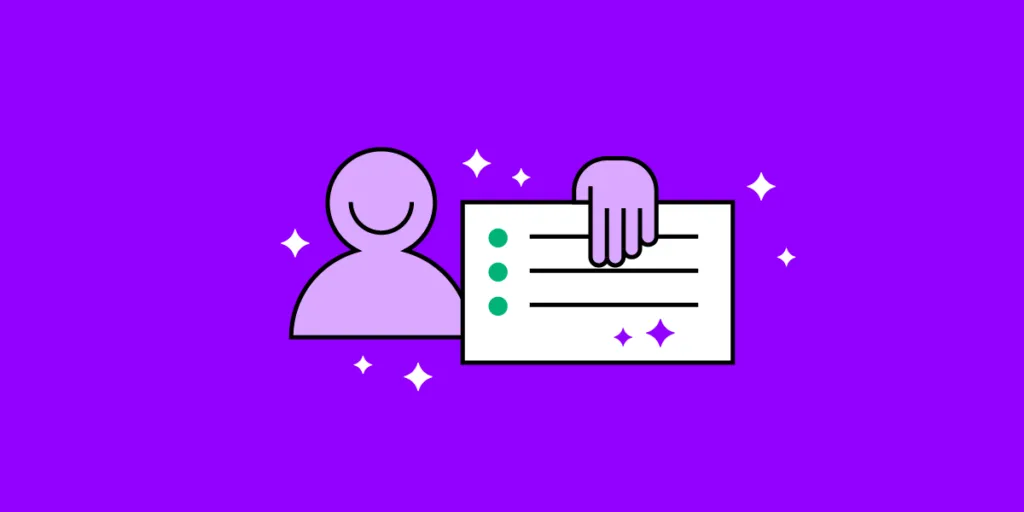
UX Design is a competitive world. Standing out from the crowd is essential for success. Crafting a compelling UX designer bio is a powerful way to showcase your unique value proposition, share your design philosophy, and present your skills and work experience.
This comprehensive guide explores the best practices for writing an engaging UX designer bio tailored for platforms like resumes, LinkedIn, and personal websites or portfolios. These guidelines and real-life UX designer bio examples will equip you to create a memorable first impression, establish credibility, and set the stage for a successful UX design career.
Stand out from the crowd by featuring final product-like prototypes in your UX portfolio. Try UXPin’s advanced features and build your first interactive prototype. Sign up for a free trial .
Build advanced prototypes
Design better products with States, Variables, Auto Layout and more.

UX Designer Bio Examples
Entry-level ux designer.
Typically, an entry-level UX designer has less than two years of experience. They may have recently graduated from a relevant program or have transitioned from another field into UX design.
Jenevieve Ghaly is a junior/entry-level UX designer from Los Angeles. Although Jenevieve has limited experience in UX, she highlights the value her psychology degree has for understanding human behavior:
“Hi! I’m a UX/UI Designer with a background in Psychology, which gives me a unique edge in empathizing with users and improving their experience through design. My research experience has refined my problem-solving skills and user insights. I’m constantly seeking new ways to learn and grow through real-world experiences.
My skills include user experience design, interaction design, user research, collaboration, problem-solving, and organization.
Let’s work together to create a seamless user experience using tools such as Figma/FigJam, Miro, Adobe XD, and Trello.”
Mid-Level UX Designer
A mid-level UX designer typically has between 2 and 5 years of experience. They have a solid foundation in UX design principles and have completed multiple projects, demonstrating their skills and ability to work independently or within a team.
Sandra Ekpechi is a mid-level UX designer from London, UK. Her bio is succinct while highlighting her core skills and experience:
“Hey there, I’m Sandra 👋🏼
🌐 I’m a user experience designer at MachineMax based in London, UK. Previously a UI/UX designer at EveryFarmer. I optimize business goals by solving human problems through user research and design.
🎨💭 I believe a product is wholesome if different kinds of users feel seen during their interactions with the product. Hence, I am passionate about human psychology, inclusive and accessible design, as well as cross-functional collaboration within teams.
🧩 In my spare time, I love to build legos, cycle, and binge standups on Netflix.”
Senior UX Designer
An expert UX designer has more than five years of experience and has demonstrated high proficiency in their craft. They may have an extensive portfolio of successful projects, a strong understanding of advanced UX design concepts, and possibly a leadership role or mentorship experience.
Adham Dannaway is an expert UX Designer and Product Designer from Sydney, Australia. We featured Adham’s website in our UX Portfolios article. Adham’s about page showcases his impressive resume with text, case studies, and visual design elements; here is the first paragraph:
“I’m a product designer based in sunny Sydney, Australia. Since 2005, I’ve enjoyed turning complex problems into simple, beautiful and intuitive designs. When I’m not pushing pixels, you’ll find me cooking, gardening or working out in the park.”– we recommend reading his entire bio for inspiration and ideas here .
Other notable UX designer bio examples:
- Camryn Manker (portfolio website)
- Melody Koh (portfolio website)
- Christopher Wong (LinkedIn)
- Allison Milchling (portfolio website)
- Vera Chen (portfolio website)
- Elisa Volpato (LinkedIn)
Importance of a Well-Crafted UX Designer Bio
A compelling UX designer bio showcases your unique value proposition, highlights your skills and experience, and increases professional opportunities. Your bio must inform potential employers, clients, and peers about your background and explain your design philosophy, problem-solving approach, and personal values.
A UX designer bio aims to create a memorable first impression, establishing your credibility in the field and distinguishing you from other professionals. A well-structured and engaging bio opens doors to networking, collaboration, and career advancement opportunities. Lastly, your bio will be vital in building your personal brand and positioning yourself for success in the competitive UX design landscape.
5 Key Elements of a Compelling Designer Bio
Personal brand statement.
A personal brand statement concisely captures your unique strengths and value proposition as a UX designer. It should communicate your design philosophy, the problems you solve, and the impact you create in just a few sentences. This statement must hook readers (recruiters, clients, hiring managers, etc.) and encourage them to learn more about your expertise.
Relevant experience
Highlight your relevant experience by showcasing your background in UX design , notable projects you’ve worked on, and the industries or clients you’ve served. Focusing on experiences demonstrating your ability to deliver results and solve design challenges helps establish your credibility and showcases your adaptability in different contexts.
Skills and expertise
Emphasize your core UX design skills and any specialized expertise that sets you apart. Consider including your proficiency in design tools , user research methods, prototyping techniques , graphic design abilities, and familiarity with programming languages or front-end frameworks . Showcasing your technical skills (HTML, CSS, and Javascript), hard skills, and soft skills demonstrates your well-roundedness and ability to contribute effectively to a team or design project.
Accomplishments
Share your professional accomplishments, such as awards, certifications , or successful projects, to demonstrate your impact in the UX design field and previous organizations. Quantify your achievements using metrics like increased conversion rates or improved user satisfaction scores . Highlighting your accomplishments showcases your ability to drive tangible results and create meaningful user experiences.
Personal values and characteristics
Include the values and characteristics that make you a unique UX designer. These can be your approach to collaboration , your dedication to user-centered design, or your passion for continuous learning. By sharing your personal traits, you connect with readers on a deeper level and present yourself as a well-rounded professional with a strong sense of purpose.
Tailoring Your UX Bio for Different Platforms
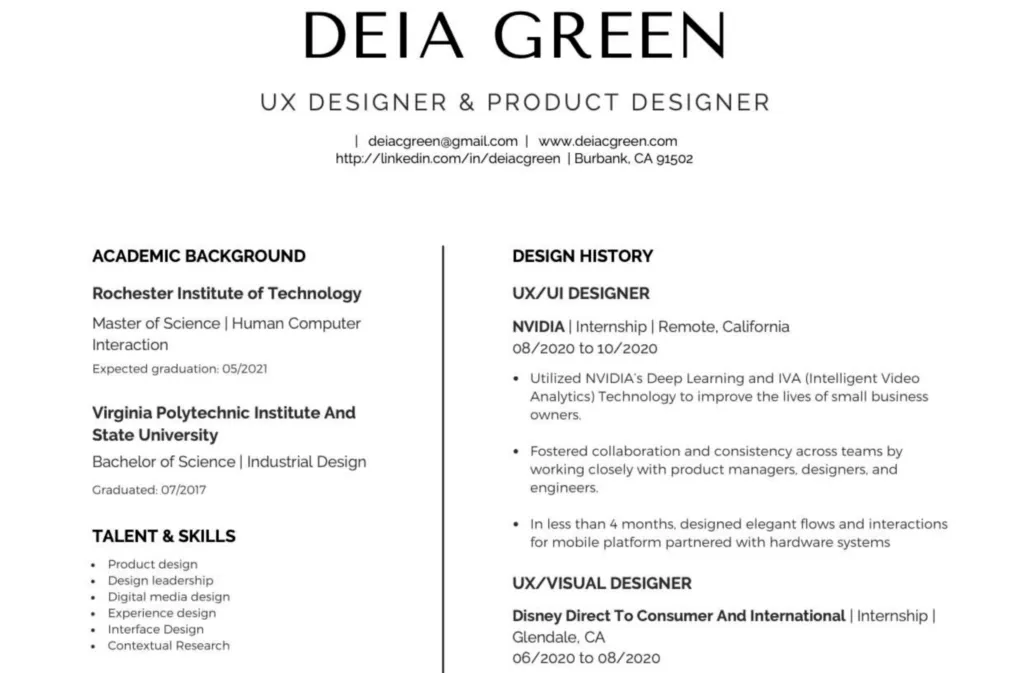
Word count recommendation: 100-150 words
Your resume bio should be concise and focused, summarizing your core skills, experiences, and accomplishments relevant to the job description you’re applying for. It serves as an introduction to your resume and provides a snapshot of your unique value as a UX designer.
Example: If the job posting emphasizes user research skills, highlight your experience conducting interviews, surveys, and usability testing, along with any notable outcomes from those projects.
Word count recommendation: 200-300 words
Your LinkedIn bio ( About section ) offers more flexibility than a resume bio, allowing you to delve deeper into your personal story, experiences, and professional goals. Use this space to showcase your personality and connect with your network on a more personal level. Also, use keywords strategically in your About section and throughout your LinkedIn bio so you show up in search results.
Example: Share a brief story about what inspired you to become a UX designer or discuss your passion for creating accessible and inclusive digital experiences.
Personal website or portfolio
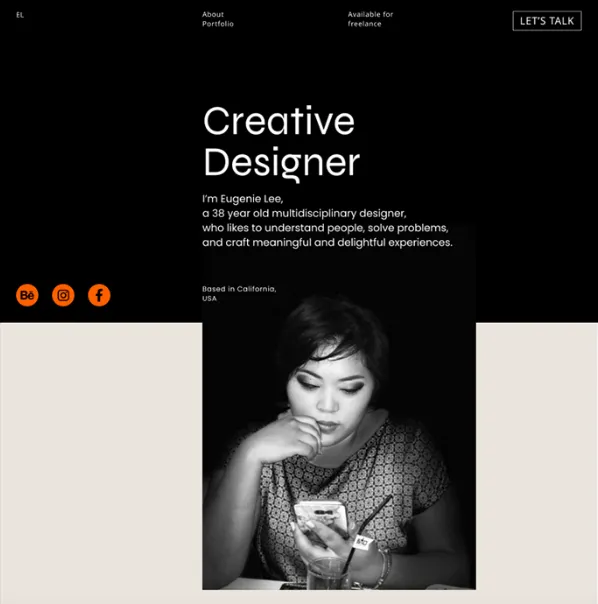
Word count recommendation: 300-500 words
Your UX design portfolio or website bio offers the most freedom to express yourself and provide a comprehensive overview of your UX design journey. Treat this as a space to share your design philosophy, showcase your thought leadership , and further detail your experiences and expertise.
Example: Explain your unique approach to UX design, such as using empathy to understand user needs or employing iterative design processes to refine and optimize user experiences. You may also create blog posts about your design approach and philosophy –which you can link to from your bio– to establish yourself as an expert or thought leader.
Best Practices for Writing a UX Designer Bio
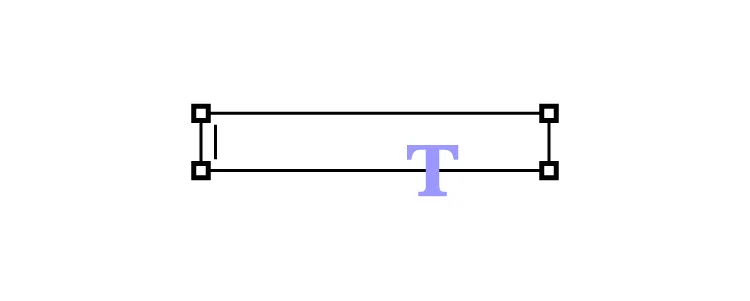
Showcase your unique value proposition
Explain what differentiates you from other UX designers, highlighting your specific skills, background, or niche expertise.
For example: “As a UX designer with a background in psychology, I specialize in creating intuitive and emotionally resonant user experiences for mental health apps .”
Emphasize your design philosophy
Share the principles that guide your design process and demonstrate how they shape your work.
For example: “I firmly believe in designing with empathy, putting users at the center of every decision to create products that truly resonate and improve lives .”
Highlight your problem-solving approach
Describe your methods for tackling design challenges and showcase how you have successfully applied them in previous projects.
For example: “Using a blend of data-driven insights and user testing , I develop innovative solutions to complex problems, leading to a 25% increase in user satisfaction in my last project.”
Quantify your achievements
Use specific UX metrics to demonstrate the tangible impact of your work, highlighting your ability to deliver results.
For example: “I have successfully led the redesign of 10+ mobile apps, resulting in a 35% average increase in user engagement and a 20% reduction in churn rate .”
Demonstrate your ability to work in a team
Share examples of your teamwork, collaboration, and communication skills to illustrate your value as a team player.
For example: “As a team lead, I foster a collaborative environment, working closely with developers, product managers, and stakeholders to ensure seamless execution of user-centered design solutions.”
Keep your bio concise and engaging
Write a concise bio using active voice and avoiding unnecessary jargon or fluff. A tool like Grammarly can help optimize your bio for grammar, fix sentence structures, and optimize for readability.
For example: “I’m a passionate UX designer dedicated to creating seamless, user-centric digital experiences that drive engagement and improve lives.”
Updating your bio regularly
Regularly review and update your bio to reflect your latest skills, experiences, certifications, and accomplishments, ensuring it stays current and accurately represents your professional growth.
For example: “I’ve recently completed Content Design London’s Advanced Content Design course, which has enhanced my expertise in creating user-centered content for digital platforms. This new skill set will enable me to deliver more effective UX design solutions that cater to diverse user needs.”
Showcase Your UX Skills With UXPin
Leverage UXPin’s advanced features to build an impressive portfolio exhibiting your wireframing, mockups, and interactive prototyping proficiency. Using UXPin to create visually engaging, high-fidelity prototypes will demonstrate your ability to bring design concepts to life, effectively communicate your design vision, and showcase your problem-solving skills in real-world scenarios.
Is your current portfolio in Sketch or Figma ? Import your projects into UXPin to impress recruiters, clients, and hiring managers with UXPin’s advanced prototyping features. Sign up for a free trial to build your first interactive prototype with UXPin today.
Build prototypes that are as interactive as the end product. Try UXPin

by UXPin on 24th April, 2023
UXPin is a web-based design collaboration tool. We’re pleased to share our knowledge here.
UXPin is a product design platform used by the best designers on the planet. Let your team easily design, collaborate, and present from low-fidelity wireframes to fully-interactive prototypes.
No credit card required.
These e-Books might interest you

Design Systems & DesignOps in the Enterprise
Spot opportunities and challenges for increasing the impact of design systems and DesignOps in enterprises.

DesignOps Pillar: How We Work Together
Get tips on hiring, onboarding, and structuring a design team with insights from DesignOps leaders.
We use cookies to improve performance and enhance your experience. By using our website you agree to our use of cookies in accordance with our cookie policy.
UX Designer CV Example
Cv guidance.
- CV Template
- How to Format
- Personal Statements
- Related CVs
CV Tips for UX Designers
- Highlight Your Design Skills and Tools : Specify your proficiency in design tools like Sketch, Figma, or Adobe XD. Also, mention your skills in wireframing, prototyping, user testing, and other UX design processes.
- Showcase Your Portfolio : Include a link to your online portfolio showcasing your best work. Use case studies to demonstrate your design process, problem-solving skills, and the impact of your designs.
- Customize Your CV for the Role : Tailor your CV to match the job description. Highlight relevant experiences and skills, such as user research for a User Researcher role or visual design for a UI Designer role.
- Detail Your Collaboration and Communication Skills : Mention your experience working with product managers, developers, and other stakeholders. Highlight your ability to communicate design ideas effectively and receive feedback.
- Quantify Your Impact : Use numbers to demonstrate the impact of your designs, such as "Increased user engagement by 30% with a redesigned interface" or "Improved user satisfaction by 20% through user testing and iterative design".
The Smarter, Faster Way to Write Your CV
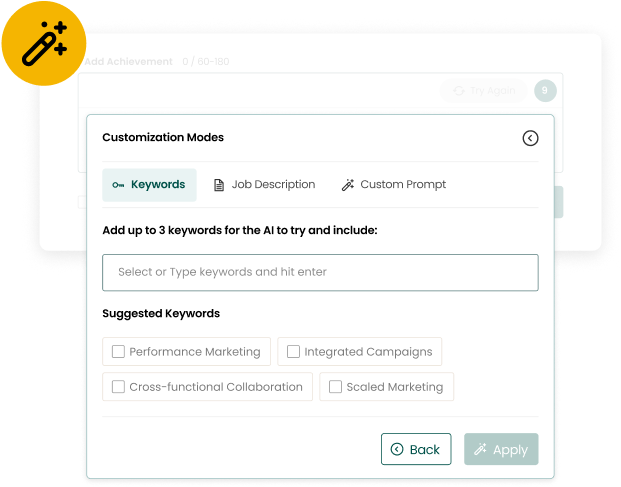
- Directed a complete redesign of the company's mobile app, resulting in a 35% increase in user engagement and a 20% increase in average session duration.
- Implemented a user-centered design approach, leading to a 50% reduction in user complaints about app usability and a 30% increase in user satisfaction scores.
- Collaborated with cross-functional teams to integrate user feedback into design iterations, improving the product's Net Promoter Score by 15 points within six months.
- Developed and executed user testing protocols for a major website overhaul, leading to a 25% decrease in bounce rate and a 30% increase in time spent on site.
- Championed the use of data-driven design decisions, resulting in a 20% improvement in conversion rates across all product lines.
- Managed a team of junior UX designers, fostering a culture of innovation and continuous learning that resulted in a 10% increase in team productivity.
- Designed and implemented a new user onboarding process for a SaaS product, reducing churn rate by 15% and increasing customer lifetime value by 20%.
- Conducted comprehensive user research, leading to the identification of three key user personas that informed the company's product development strategy.
- Initiated a company-wide UX training program, increasing the organization's understanding of user-centered design principles and fostering a more user-focused culture.
- User-Centered Design
- Mobile App Design
- User Testing Protocols
- Data-Driven Design Decisions
- Team Management
- User Onboarding Design
- User Research
- UX Training Development
- Cross-Functional Collaboration
- Product Development Strategy
UX Designer CV Template
- Collaborated with [teams/departments] to design and implement [UX project, e.g., mobile app interface, website redesign], resulting in [measurable impact, e.g., increased user engagement, improved customer satisfaction].
- Conducted [type of research, e.g., user interviews, usability testing] to understand [user needs/behaviors], informing [design decision or strategy, e.g., feature development, interface layout].
- Championed [design process or tool, e.g., prototyping, user journey mapping], leading to [quantifiable benefit, e.g., 20% faster project completion, improved design quality].
- Played a key role in [project or initiative, e.g., product launch, website overhaul], which led to [measurable impact, e.g., increased user retention, improved conversion rates].
- Utilized [design software/tools, e.g., Sketch, Adobe XD] to create [design deliverable, e.g., wireframes, interactive prototypes], enhancing [aspect of user experience, e.g., usability, accessibility].
- Instrumental in [task or responsibility, e.g., user testing, design reviews], ensuring [quality or standard, e.g., consistency, user-centered design] across all UX projects.
- Major: Name of Major
- Minor: Name of Minor
100+ Free Resume Templates
How to format a ux designer cv, start with a compelling summary, emphasize design skills and tools, detail relevant projects and experience, highlight soft skills and research proficiencies, include a portfolio link, personal statements for ux designers, ux designer personal statement examples, what makes a strong personal statement.
Match & Compare Your CV to a Job Description

CV FAQs for UX Designers
How long should ux designers make a cv, what's the best format for an ux designer cv, how does a ux designer cv differ from a resume, related cvs for ux designer.
User Experience Designer CV
UI Designer CV
Senior UX Designer CV
Junior UX Designer CV
Freelance UX Designer CV
Digital Product Designer CV
Try our AI-Powered Resume Builder
- Applying to Uni
- Apprenticeships
- Health & Relationships
- Money & Finance
Personal Statements
- Postgraduate
- U.S Universities
University Interviews
- Vocational Qualifications
- Accommodation
- Budgeting, Money & Finance
- Health & Relationships
- Jobs & Careers
- Socialising
Studying Abroad
- Studying & Revision
- Technology
- University & College Admissions
Guide to GCSE Results Day
Finding a job after school or college
Retaking GCSEs
In this section
Choosing GCSE Subjects
Post-GCSE Options
GCSE Work Experience
GCSE Revision Tips
Why take an Apprenticeship?
Applying for an Apprenticeship
Apprenticeships Interviews
Apprenticeship Wage
Engineering Apprenticeships
What is an Apprenticeship?
Choosing an Apprenticeship
Real Life Apprentices
Degree Apprenticeships
Higher Apprenticeships
A Level Results Day 2024
AS Levels 2024
Clearing Guide 2024
Applying to University
SQA Results Day Guide 2024
BTEC Results Day Guide
Vocational Qualifications Guide
Sixth Form or College
International Baccalaureate
Post 18 options
Finding a Job
Should I take a Gap Year?
Travel Planning
Volunteering
Gap Year Guide
Gap Year Blogs
Applying to Oxbridge
Applying to US Universities
Choosing a Degree
Choosing a University or College
Personal Statement Editing and Review Service
Guide to Freshers' Week
Student Guides
Student Cooking
Student Blogs
- Top Rated Personal Statements
Personal Statement Examples
Writing Your Personal Statement
- Postgraduate Personal Statements
- International Student Personal Statements
- Gap Year Personal Statements
Personal Statement Length Checker
Personal Statement Examples By University
Personal Statement Changes 2025
- Personal Statement Template
Job Interviews
Types of Postgraduate Course
Writing a Postgraduate Personal Statement
Postgraduate Funding
Postgraduate Study
Internships
Choosing A College
Ivy League Universities
Common App Essay Examples
Universal College Application Guide
How To Write A College Admissions Essay
College Rankings
Admissions Tests
Fees & Funding
Scholarships
Budgeting For College
Online Degree
Platinum Express Editing and Review Service
Gold Editing and Review Service
Silver Express Editing and Review Service
UCAS Personal Statement Editing and Review Service
Oxbridge Personal Statement Editing and Review Service
Postgraduate Personal Statement Editing and Review Service
You are here
- Mature Student Personal Statements
Personal Statements By University
- Accountancy and Finance Personal Statements
- Actuarial Science Personal Statements
- American Studies Personal Statements
- Anthropology Personal Statements
- Archaeology Personal Statements
- Architecture Personal Statements
- Art and Design Personal Statements
- Biochemistry Personal Statements
- Bioengineering Personal Statements
- Biology Personal Statements
- Biomedical Science Personal Statements
- Biotechnology Personal Statements
- Business Management Personal Statement Examples
- Business Personal Statements
- Catering and Food Personal Statements
- Chemistry Personal Statements
- Classics Personal Statements
- Computer Science Personal Statements
- Computing and IT Personal Statements
- Criminology Personal Statements
- Dance Personal Statements
- Dentistry Personal Statements
- Design Personal Statements
- Dietetics Personal Statements
- Drama Personal Statements
- Economics Personal Statement Examples
- Education Personal Statements
- Engineering Personal Statement Examples
- English Personal Statements
- Environment Personal Statements
- Environmental Science Personal Statements
- Event Management Personal Statements
- Fashion Personal Statements
- Film Personal Statements
- Finance Personal Statements
- Forensic Science Personal Statements
- Geography Personal Statements
- Geology Personal Statements
- Health Sciences Personal Statements
- History Personal Statements
- History of Art Personal Statements
- Hotel Management Personal Statements
- International Relations Personal Statements
- International Studies Personal Statements
- Islamic Studies Personal Statements
- Japanese Studies Personal Statements
- Journalism Personal Statements
- Land Economy Personal Statements
- Languages Personal Statements
- Law Personal Statement Examples
- Linguistics Personal Statements
- Management Personal Statements
- Marketing Personal Statements
- Mathematics Personal Statements
- Media Personal Statements
- Medicine Personal Statement Examples
- Midwifery Personal Statements
- Music Personal Statements
- Music Technology Personal Statements
- Natural Sciences Personal Statements
- Neuroscience Personal Statements
- Nursing Personal Statements
- Occupational Therapy Personal Statements
- Osteopathy Personal Statements
- Oxbridge Personal Statements
- Pharmacy Personal Statements
- Philosophy Personal Statements
- Photography Personal Statements
- Physics Personal Statements
- Physiology Personal Statements
- Physiotherapy Personal Statements
- Politics Personal Statements
- Psychology Personal Statement Examples
- Radiography Personal Statements
- Religious Studies Personal Statements
- Social Work Personal Statements
- Sociology Personal Statements
- Sports & Leisure Personal Statements
- Sports Science Personal Statements
- Surveying Personal Statements
- Teacher Training Personal Statements
- Theology Personal Statements
- Travel and Tourism Personal Statements
- Urban Planning Personal Statements
- Veterinary Science Personal Statements
- Zoology Personal Statements
- Personal Statement Editing Service
- Personal Statement Writing Guide
- Submit Your Personal Statement
- Personal Statement Questions 2025
- Personal Statement Changes 2024
Design Personal Statement Examples
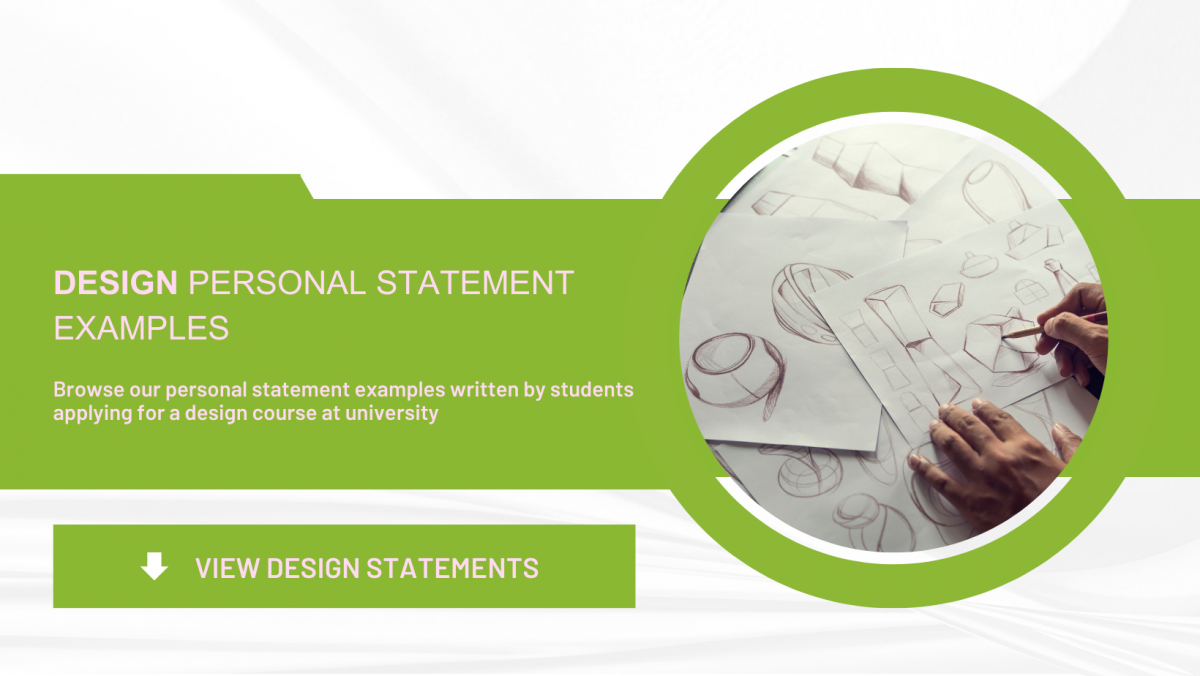
What is a design personal statement?
Writing a personal statement for design is a chance to sell yourself to the admissions tutors and show them why you would make a great design candidate. It’s a place to describe your skills and strengths, as well as your career plans.
You are allowed up to 4000 characters to explain why you are applying for a design degree, so you need to make sure your statement is as polished as possible to stand out from the crowd.
How do I write a good design personal statement?
Good design personal statements always use evidence to support their claims. You need to convince admissions tutors that you’re a good match for the programme, so if you claim to be committed or inquisitive, then use examples from your life to back it up.
To write a great design personal statement you need to start early, brainstorm some ideas, and then begin your first draft.
This will then need to be carefully revised and edited before asking family and friends for feedback. Incorporate their comments and suggestions, and see how it is improved before asking them to look at it again.
Read through our design personal statement examples to give you an idea of what a good design statement entails.
Make sure you proofread your statement for grammar and spelling before sending it off, and if you feel you need a little extra help, take a look at our personal statement editing services .
What should I include in my design personal statement?
Many students choose to start their statement by picking a specific aspect of design and explaining why they enjoy it.
Admissions tutors want candidates that are as passionate about the subject as they are.
As well as your motivations for studying design, think about your hobbies and extracurricular activities too. What skills have you learned from these and how will these help you in your design degree?
Talk about any work experience placements you have completed, e.g. shadowing an architect or design technician. What did you take away from this experience? Do you feel you have all the necessary personal traits and qualities that make a good design student?
Your wider reading is also important, so it's worth mentioning anything you've read recently that you found interesting and why. Generally, admissions tutors like students who express their views and opinions, and can back them up with evidence.
For more help and advice on what to write in your design personal statement, please see:
- Personal Statement Editing Services
- Personal Statement Tips From A Teacher
- Analysis Of A Personal Statement
- The 15th January UCAS Deadline: 4 Ways To Avoid Missing It
- Personal Statement FAQs
- Personal Statement Timeline
- 10 Top Personal Statement Writing Tips
- What To Do If You Miss The 15th January UCAS Deadline.
Related resources

Find out more
Uni Open Day Tips

How To Apply To University

10 Personal Statement Don'ts
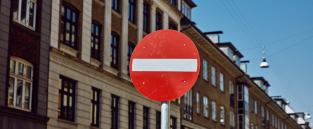
A Level Results Day

Clearing Guide

20 of the Best UX Portfolio Examples
So, you’re looking for some UX portfolio inspiration?
Making sure you’ve got an impressive portfolio to your name is important for both fresh-faced UX designers and seasoned industry veterans.
In this article, we’ll try to inspire you with awesome UX portfolio examples and UX design portfolio best practices.
The 20 Best UX Portfolios
Without further ado, here are our picks of the best UX design portfolio examples.
1. Gloria Lo nails the high-impact introduction
Who is gloria lo.
Gloria Lo is a self-taught product designer based in Sydney, Australia. In her own words, she is passionate about improving the lives of others through design and is constantly looking to learn new things every day.
What makes Gloria’s UX design portfolio so great?
One of the first things your UX portfolio should do is introduce you as a designer. Employers and potential clients want to know who you are and what you’re all about—and they should be able to find this out within seconds of landing on your portfolio website.
Gloria has nailed her designer introduction with a three-tiered approach. First, she treats us to a bold, eye-catching headline that describes her in terms of her favorite activities.
In just four simple verbs, we know that Gloria is a creative, multi-talented soul with quite a few hobbies in her repertoire. Oh, and these verbs “light up” in different colors when you hover over them—a nice additional dash of personality!
After such an enticing headline, we’re inevitably curious to know more about Gloria—and sure enough, her portfolio delivers. Directly beneath that unmissable heading, Gloria tells us exactly what she does and what she’s passionate about in just two sentences.
Gloria has mastered the delicate art of brevity while still managing to convey the most important information—not an easy feat!
By now, Gloria has well and truly piqued the viewer’s interest. Luckily, her portfolio also features a comprehensive “About” page, complete with a video, a section detailing her values (with the help of emojis), a very thorough testimonial from a former employer, and links to her music and artwork.
What can we learn from Gloria Lo?
When it comes to your own UX design portfolio, make like Gloria and be sure to include a meaningful introduction. Keep it compact yet high-impact on the home page, and then provide more detail in a dedicated “About” section.
Besides crafting a gripping “about me” statement, try to inject a bit of personality into the visual design, too—just like Gloria’s colorful hover effect.
Key takeaway
The viewer should know exactly who you are and what you do within seconds of landing on your UX design portfolio. Craft a compelling headline that provides all the most important information at a glance.
View Gloria Lo’s full portfolio website
2. Moritz Oesterlau masters the art of storytelling through case studies
Who is moritz oesterlau.
Moritz Oesterlau is a multi-skilled product/UX designer based in Germany. He also dabbles in interface design and frontend development.
Moritz studied UX design with CareerFoundry and is now part of the Global Goals Curriculum 2030 team, helping to shape a democratic, just, and sustainable society through the power of education.
What makes Moritz’s UX design portfolio so great?
Moritz’s portfolio really gets to the heart of what UX design is all about: going through a process to solve a user problem. Moritz doesn’t just show the finished product; he shares, in detail, all the methods and processes that got him there.
Each project is presented as a case study, which immediately tells us we’re in for a lot more than just eye candy.
Click on any one of these case studies and you almost feel like you’re in the room with Moritz himself—a fly-on-the-wall as he works through his UX design process.
Take the Approach to Digitization in Education case study , for example. Moritz leaves no stone unturned, documenting the project from start to finish.
He takes us on a logical journey, putting the design challenge into context before going through competitor analysis , interviews and surveys, building empathy and creating user personas , defining the information architecture , wireframing , prototyping, and usability testing .
For each step, he explains what he did, why he did it, and what he learned as a result.
What can we learn from Moritz Oesterlau?
When showcasing your UX design work, follow Moritz’s example and place your process front and center. You’ll notice that Moritz doesn’t show the finished product until the very end of each case study, and that’s because he’s telling a logical story.
With each case study, start from the beginning and guide the viewer through the main steps that led you to the final solution. It’s okay to include screenshots of a beautiful end product, but make sure you’ve documented your process in detail first.
Showcase your process, not just the finished product. Write about the methods you used, what you learned along the way, the challenges you came up against, and how you solved certain problems. Each case study should tell a complete, logical story.
View Moritz Oesterlau’s full portfolio website
3. Elizabeth Lin reigns supreme with visual storytelling
Who is elizabeth lin.
Elizabeth Lin is a San Francisco-based product designer and self-proclaimed fashion, teaching, and classical saxophone enthusiast.
What makes Elizabeth’s UX design portfolio so great?
Elizabeth Lin’s portfolio provides another excellent example of storytelling. Just like Moritz, she presents her design work in the form of case studies, documenting her process from start to finish.
What really stands out in Elizabeth’s portfolio, though, is her use of visuals to support the narrative she’s weaving.
Each point in her case study is illustrated with some kind of visual element—be it a virtual wall of Post-it notes, a survey form that was sent to research participants, or early-stage prototypes.
Another effective storytelling technique that Elizabeth uses is to include little bitesized notes and reflections down the right-hand side.
Set in a different font and color to the main body text, these snippets catch your eye as you scroll.
They provide further, more personal insights into the project—such as “It was cool seeing how differently teachers would use this dashboard” or “We didn’t move forward with this exploration because we wanted to validate the base solution first.”
Supporting your case studies with visual artifacts really brings the project to life. Elizabeth’s portfolio illustrates perfectly how visual and textual storytelling should work together to demonstrate your UX design process.
What can we learn from Elizabeth Lin?
The aim of your UX portfolio is to both show and tell. Just like Elizabeth, support each case study with meaningful visuals—that is, real artifacts from your project, not just illustrations.
Every time you work on a new design project, document your process: take screenshots of user research surveys you send out, snap photos of your wall covered in sticky notes after a heavy brainstorming session, and keep hold of your wireframes as they progress from low to high fidelity.
When it comes to adding a new case study to your portfolio, these artifacts will help you tell a logical story.
Don’t just tell the story of each project; bring it to life with visual artifacts. For each step you go through in your case study, include a photo or screenshot of how it looked in action.
View Elizabeth Lin’s full portfolio website
4. Olivia Truong showcases her approach to problem-solving
Who is olivia truong.
Olivia Truong is a product designer based in Boston, Massachusetts. In her own words, Olivia likes to go out into the world and capture its beauty and weirdness.
What makes Olivia’s UX design portfolio so great?
Above all else, UX designers are problem-solvers. Your UX design portfolio should therefore demonstrate how you identify and tackle a variety of user problems. Olivia’s portfolio does a great job of this, as you’ll see in her Routr case study .
Olivia kicks off her case study by framing the problem in a personal, relatable way. She doesn’t just talk about the “user” problem—she frames it as “our” problem, inviting the reader to step into the user’s shoes, just as she has done.
Next, Olivia explains, in detail, how she set about trying to solve this problem—in a section aptly named “There Must Be Something Out There”. We learn how she scoured the internet and App Store for a solution, only to find that none of the existing solutions fit the bill.
In the section that follows, “Taking The Dive”, Olivia shares the next steps in her problem-solving journey: brainstorming the elements of a successful date.
After thoroughly framing the problem and describing her approach to solving it, Olivia moves onto “The Making Of Routr.” Notice how, even when talking about her solution, Olivia consistently refers back to the original user problem.
Olivia’s portfolio portrays her as a thoughtful problem-solver—granting her huge bonus points in the eyes of any recruiter or potential client. This focus on problem-solving also conveys another essential UX trait: empathy for the user.
When reading Olivia’s case study, you don’t get the feeling that she’s just going through the motions; she’s genuinely engaged in the problem and how she can solve it for the user. That’s the sign of a passionate UX designer!
What can we learn from Olivia Truong?
UX designers are problem-solvers, so make sure your portfolio reflects that. There are two key lessons we can learn from Olivia’s portfolio: first, start each case study by framing the problem in detail, and second, frame the problem in a way that conveys empathy.
Above all, think about the language you use. Don’t just state the problem; relate to it and put some emotion behind it! Olivia describes how planning dates was a “headache” because “coming up with ideas was not the easiest thing to do in our busy lives.”
This is much more personal and empathy-driven than if she’d said “Users struggle to come up with date ideas because they’re so busy.” Last but not least, refer back to the original problem throughout—even when you progress to the solution.
Your UX design portfolio should demonstrate your approach to problem-solving. Kick off each case study by framing the problem in detail, using emotive language to convey empathy. Refer back to the problem throughout.
View Olivia Truong’s full portfolio website
5. Priyanka Gupta is the queen of the unsolicited redesign
Who is priyanka gupta.
Priyanka Gupta is a product designer and tech enthusiast based in San Francisco. Aside from creating awesome user experiences, Priyanka is also pretty active on Medium .
What makes Priyanka’s UX design portfolio so great?
Early on in your UX career, you might struggle to fill your portfolio with real projects. As your career progresses, you might look for ways to make your portfolio stand out. So what can you do?
Cue the unsolicited redesign à la Priyanka Gupta.
When Priyanka runs into bad UX, she can’t help but do something about it. Where most of us might just abandon ship and find an alternative product, Priyanka goes above and beyond: she redesigns the entire experience!
So, in addition to real client projects, Priyanka’s UX portfolio also showcases some rather impressive unsolicited redesigns.
One can’t help but be impressed by Priyanka’s initiative and drive. She’s gone out of her way to redesign an entire digital experience, just because she’s passionate about good UX—how cool is that?!
What’s also interesting is how Priyanka chooses to showcase these redesigns. She could just stick to the standard case study format, but as we know, she’s the kind of designer who likes to go above and beyond.
Click on one of her unsolicited portfolio pieces and you’ll be taken to a full-on, published blog post. Nice!
Despite the fact that these unsolicited redesigns are pure “passion projects”, Priyanka lends them the credibility they deserve by documenting her process in detail.
In her redesign of the Sephora iOS app , she starts by framing the problem: “Despite using the app religiously, I had trouble navigating through it. After observing that other people also experienced issues with the app, I pursued this redesign as an opportunity to improve the experience in any way I could.”
What follows is a detailed breakdown of every step she took to redesign the app, from brand analysis, user research, and affinity mapping , right through to persona creation, prototyping, and implementation—not forgetting those all-important visual artifacts that are absolutely crucial to UX storytelling!
What can we learn from Priyanka Gupta?
Priyanka is an experienced UX designer who presumably has plenty of real projects for her portfolio. This doesn’t stop her from conducting unsolicited redesigns when she comes across intolerably bad UX—as she puts it, it’s like an itch she just needs to scratch!
If you’re a new UX designer trying to build up your portfolio, take a leaf out of Priyanka’s book and complete some unsolicited redesigns of your own. This is a great way to demonstrate initiative and show that you’re a proactive designer who is willing to go the extra mile.
Just as Priyanka does, be transparent about the fact that these are unsolicited projects—a simple disclaimer is all you need.
Another valuable takeaway from Priyanka’s portfolio is the power of blogging. Priyanka doesn’t just limit herself to her portfolio website; she also shares her case studies and tips via Medium (where she’s accrued over a thousand followers!).
There are many different ways to share your process, so don’t be afraid to try a multichannel approach.
Unsolicited redesigns are an excellent way to build up your UX portfolio and demonstrate your initiative as a designer. As always, frame the problem, document your process, and tell a good story—and don’t forget to include a disclaimer.
View Priyanka Gupta’s full portfolio website
6. Lola Jiang delivers measurable outcomes and metrics
Who is lola jiang.
Lola Jiang is a California-based UX designer currently working at Google. Lola’s impressive resume includes having worked at YouTube as an interaction designer.
What makes Lola’s UX design portfolio so great?
One of the biggest challenges you’ll face as a UX designer is measuring and demonstrating the impact of your work. You know you’ve improved the user experience, but how do you substantiate that?
Look no further than Lola Jiang’s portfolio. Lola does an extremely important (yet scarce) thing: she puts the measurable impact of her UX design in the context of business needs.
Take her AI Training Platform case study, for example. Following a brief introduction to the project (literally one sentence), Lola offers the project’s outcomes: “The new design reduced task times by 68% and improved users’ subjective satisfaction by 139%.”
It’s immediate and impactful. Lola then takes us through the flow of the project, outlining the scale and scope of the work. She details the challenges, different iterations, and design, and clearly demonstrates the motivations behind decisions.
Lola rounds off her case study with a post-relaunch analysis, using concrete data to validate the final redesign: “With the original design, the set of tasks took 19 minutes. With the new design, the set of tasks took 6 minutes. Nearly 68%. Users’ subjective satisfaction with the new design (4.3/5) was 139% higher than the original design (1.8/5).”
What can we learn from Lola Jiang?
Lola does a great job of showing how she works in a business setting. This is crucial if you want to practice UX for a living, but it’s a trick that many designers tend to miss. While it’s true that you’re there to advocate for the user, it’s also important to recognize that companies have their own goals to meet—and you need to show how UX contributes to that.
If, like Lola, you can demonstrate how your work brings value, you’ll set yourself up for some serious bonus points. If you have data related to the project, this will be easy—but what if there aren’t any concrete metrics to showcase?
Even without data, you can frame your work in a business context. Set a business or product goal at the start of the case study. What do you hope your work will achieve? This is separate from the user goal, but the two should go hand in hand.
For example, creating a more pleasant app experience for the user should help to boost customer retention.
Likewise, establish a few success metrics before you begin. How will you measure the impact of your work? What tell-tale signs will you look out for after you’ve launched or relaunched the product? The best UX designers are those who can advocate for the user while meeting the needs of the business, so try to convey this throughout your portfolio.
Use your portfolio to demonstrate how you add value to the business. Set business goals and success metrics for each case study, and, where possible, include data and tangible outcomes.
View Lola Jiang’s full portfolio website.
7. Daniel Autry features “just the right amount” of portfolio projects
Who is daniel autry.
Daniel Autry is a designer, developer, and behavioural researcher based in Charlottesville, Virginia. He is fascinated by the social product space and is currently researching the intersection between technology and mental illness.
What makes Daniel’s UX design portfolio so great?
Daniel Autry’s portfolio features some remarkable work in the mental health space, but that’s not the only reason he’s made it onto this list. Daniel’s portfolio also helps to answer that all-too-common conundrum: What’s the “right” amount of projects to showcase in your UX design portfolio?
Before we go any further, let’s be clear on one thing: There’s no “magic number” when it comes to portfolio projects. Some people will tell you five, others will say three—you might even hear that one is enough!
Daniel has opted to showcase four projects in his UX portfolio, and while we’re not saying that he’s found THE magic number, it is a magic number of sorts.
In other words, Daniel has found the number that works for him: He features just enough projects to showcase his range as a designer while still keeping it limited enough so as not to overwhelm the user—smart UX design in action!
In the space of just four featured case studies, we see that Daniel is a versatile designer who has worked on a variety of projects across a range of sectors—from mental health to financial trading to e-learning. So, it’s not just about how many projects you showcase; it’s just as important to pick a good variety.
Besides his four featured projects, Daniel’s portfolio also includes a section dedicated to “Other Works”. Here, he links to articles he’s written on Medium, additional projects he’s worked on, as well as upcoming endeavors.
This is a great way to divide your portfolio, especially if you’re struggling to decide which of your best work should feature!
What can we learn from Daniel Autry?
Daniel’s portfolio teaches us an important lesson about the “right” number of portfolio projects: There isn’t one! Every UX designer is unique, and your portfolio should reflect that.
Don’t get too hung up on whether you should include three projects or five; focus instead on selecting a handful of projects that best showcase who you are as a designer.
If you want to brand yourself as a versatile, adaptable designer, feature as diverse a variety of projects as possible.
If you see yourself as a specialist in a certain industry, highlight the projects that demonstrate this. At the same time, don’t overwhelm the viewer: a hiring manager looking through your portfolio probably won’t browse through ten UX case studies, so choose wisely!
There is no hard-and-fast rule when it comes to how many projects you should feature in your portfolio. Choose a good enough variety to showcase your skillset, while keeping it minimal enough so as not to overwhelm the user. If you’ve got lots more work you want to showcase, add a separate section.
View Daniel Autry’s full portfolio website
8. Vera Chen highlights the importance of context
Who is vera chen.
Vera Chen is a product designer and former Facebook intern. She has a Master’s degree in Human-Centered Design and Engineering, and has also dabbled in singing and acting.
What makes Vera’s UX design portfolio so great?
Not only is Vera’s portfolio a beautiful thing to behold (just look at those illustrations!); it also highlights the importance of context when presenting your UX work.
Vera doesn’t just outline the problem statement for each case study—she steeps it in a solid back story, describing the events that led her there. She also clearly explains her role on each project, who she worked with, and what design and prototyping tools and methods they used.
Just by including these few extra details, Vera paints a clear picture of what the project entailed and how she contributed. Another excellent example of UX storytelling!
Let’s take Vera’s Wedding Library case study , for example. See how she dedicates two whole sections to setting the scene? First, there’s the project background which lays out the scope of the project. Then there’s the context section, a detailed story about newlyweds Murphy and Diana and the frustrations they faced when planning two weddings.
Vera doesn’t just tell us what the problem is. She shows us exactly how it came to light, and in what capacity she was employed to help solve it. By the time we scroll down to Vera’s process, it’s easy to see where each step fits into the overall project.
It’s a bit like reading a novel: you need a little bit of background before you can start relating to the characters and the plot.
What can we learn from Vera Chen?
There are two very simple yet effective takeaways to be had from Vera’s portfolio. First and foremost, provide plenty of background context—this works wonders when telling the story of each case study.
Vera doesn’t start with the problem statement; she sets the scene, describing the people, events, and circumstances that surround and lead up to this particular design challenge. Aim to precede your problem statement with a small paragraph dedicated to “setting the scene”.
Secondly, state your role on each project. What were you commissioned to do? Where did you fit into the overall team? At the same time, listing your teammates is a nice touch; UX design is a highly collaborative field, so it’s important to demonstrate individual value while acknowledging that the end result was a team effort!
For each case study in your UX portfolio, provide as much context as you can. Set the scene with a brief backstory before launching into your problem statement. This includes stating your role on the project and, if necessary, who you worked with.
View Vera Chen’s full portfolio website
9. Zara Drei bedazzles with awesome UX and UI
Who is zara drei.
Zara Drei is a London-based UX designer. When she’s not solving problems with beautiful, user-centric web products, you can find her playing around with electronics, making video loops, building ceramic and metal sculptures, or producing electronic music.
What makes Zara’s UX design portfolio so great?
We’ve talked a lot about the importance of showcasing your UX design process. Now it’s time to contemplate the power of beautiful UI! This brings us to Zara Drei’s portfolio—the epitome of digital elegance.
Zara specializes in creating digital products and experiences for luxury, fashion, and beauty brands, and this is reflected in every detail of her portfolio.
In fact, scrolling through Zara’s portfolio is like wandering through the beauty department of a high-end store, or flipping through the pages of a glossy magazine—and that’s no accident.
She has given as much thought to her color palette , typography , and imagery as she has to writing up her case studies and sharing her process. The result? A flawless portfolio that truly makes its mark.
What can we learn from Zara Drei?
Your UX design portfolio is not just a website—it’s part of your personal brand. Like your case studies, the overall aesthetic of your portfolio should tell a story about who you are as a designer. Consider how Zara uses color and imagery to evoke a sense of luxury throughout her portfolio; how can you create a similar effect?
Spend some time figuring out your personal brand. Are you fun and quirky? Artsy and edgy? Corporate and serious? Perhaps you’re all about eco-friendly design.
Once you’ve got a theme in mind, you can start to think about the kinds of colors and imagery that will help to convey this. Just because you’re a UX designer doesn’t mean you can neglect the visual design of your portfolio.
Your portfolio should embody your personal brand, so treat it like any other UX project and give it the high-shine finish it deserves!
Your portfolio website should reflect your personal brand, and visual design plays a crucial role. The best portfolios offer the full package—detailed case studies wrapped in stunning UI design and flawless UX—so aim to tick all the boxes!
View Zara Drei’s full portfolio website
10. Minimalism from Victoria Kazakova
Who is victoria kazakova.
Victoria Kazakova is a Polish UX designer, web developer, and photographer.
What makes Victoria’s UX design portfolio so great?
In the enormous and sometimes confusing online world we trawl through daily, Victoria Kazakova’s UX portfolio wins the prize for clarity and ease of understanding.
Throughout Victoria’s portfolio, she sticks to a minimalist design palette and clear signage, a simplicity that makes for a delightfully smooth read.
Better still, words that spring up on command stroll through the portfolio, leading the reader from section to section.
Charts and graphics displaying her skills and experience are so simple they appear iconic. There’s no chance the reader could feel lost or confused.
What can we learn from Victoria Kazakova?
When it comes to graphic design, sometimes simplicity is best. The last thing you want to happen when someone reads over your portfolio is for them to feel overwhelmed with data.
Victoria’s portfolio is a great example of how responsive screens can ease the user’s journey through pages of information.
Don’t be tempted to overload. Stick to two classy fonts and an inoffensive colorway. These simple building blocks can lead the user’s eye as they navigate your work.
View Victoria Kazakova’s full UX portfolio
11. Yu-Hsuan offers zero-gravity UX
Who is yu-hsuan.
Yu-Hsuan is a UX designer, currently working for Google as an interaction designer.
What makes Yu-Hsuan’s UX design portfolio so great?
Yu-Hsuan’s impressive role at Google means that many of her current projects are “locked” due to non-disclosure agreements. This is a common problem in the UX design community and a hurdle many designers face when putting together their portfolios.
Yu-Hsuan’s deft solution is to focus on the illustrative side of her UX portfolio, which showcases her passion and side projects as a graphic designer and game designer.
She also uses her illustrations to depict the otherwise locked aspects of the projects she’s describing. This gives a lovely cohesion with the rest of the content in her portfolio and reduces the jarring effect locked projects can sometimes have.
The floating designer illustration that seems to hover over the portfolio is very cool and points at a sense of fun and creativity necessary to succeed in illustration and gaming.
What can we learn from Yu-Hsuan?
Through her illustrations, Yu-Hsuan has subtly displayed her UX skills in her portfolio itself.
This visual approach means the separate parts of the portfolio hang together perfectly, even when some of the projects are locked off.
Another tip from Yu-Hsuan is to be approachable in your portfolio. Dropping in the line “Please contact me if you want to go through the case study” gives a real sense of openness, collaboration, and sharing.
If you can’t show direct evidence of a project, don’t hesitate to get creative. A strong visual style not only shows off your design chops but helps a large portfolio hang together nicely. Also, be approachable!
View Yu-Hsuan’s full UX portfolio
12. A holistic introduction to Cristina Gafitescu
Who is cristina gafitescu.
Romania-based Cristina Gafitescu is a junior UX designer with a playful approach to visual design.
What makes Cristina Gafitescu’s UX design portfolio so great?
Cristina’s UX portfolio makes a great first impression as it tells her story in an interesting-to-follow, visually engaging way.
Her playful page layouts and graphics show Cristina’s panache as an illustrator and designer. They also provide a great backdrop as she offers a holistic introduction to herself.
Through a post-it note, almost diaristic approach, the reader really gets a feel for what kind of person Cristina is, her education and experience, and what attracted her to UX in the first place.
That’s not to say this portfolio is totally informal. Cristina also does a great job of showing her processes, identifying problems (with a focus on UX research), solutions, and testing.
When the temptation may be to opt for oblique, abstract graphics that display your design chops in the coolest terms, save a thought for a more intimate approach.
Cristina’s portfolio is emotionally honest, charming, and informative. The effect on recruiters—especially those suffering from portfolio fatigue—is likely persuasive.
View Cristina Gafitescu’s full UX portfolio
13. The spatial awareness of Rucha Moghe
Who is rucha moghe.
Rucha Moghe is a UX designer with a background in architecture based in India.
What makes Rucha Moghe’s UX design portfolio so great?
From start to finish, Rucha’s UX portfolio ticks all the right boxes. It’s visually strong and easy to digest. Her user journey map is smart and in context, and the user flows, wireframes, and usability study are all useful.
Tehni: A Plant App is an especially great case study and easy to follow. On the whole, Rucha’s portfolio is incredibly strong on user personas.
As Rucha suggests, her background as an architect provides her portfolio with a great sense of user-centered design principles, spatial awareness, and problem-solving skills transferable to digital spaces.
No space feels wasted, nothing is jumbled, and the reader never feels lost or confused. This is architectural elegance in portfolio form.
Reinventing the wheel in your portfolio isn’t necessarily a good idea. Rucha’s portfolio nails the basics: it’s logical with an easy-to-follow narrative that shows how user problems were solved. It’s bold and eye-catching and features great user personas.
View Rucha Moghe’s full UX portfolio
14. Nguyen Duc Thang’s deep case studies
Who is nguyen duc thang.
Nguyen Duc Thang is a UX designer based in Hanoi, Vietnam. Although just starting in his career, Nguyen Duc Thang knows how to put together a really strong portfolio.
What makes Nguyen Duc Thang’s UX design portfolio so great?
Much like Rucha Moghe, Nguyen Duc Thang’s UX portfolio gets the basics right despite the difference in experience.
Nguyen Duc Thang’s branding is particularly strong, with eye-catching graphics consistently holding the content together throughout the document.
After introducing himself, Nguyen Duc Thang covers his skills and qualifications before launching into extensive case studies. No stone is left unturned in these exhaustive examples, which detail wireframing, prototyping, testing, user personas, visual design, and information architecture. Bravo!
Don’t scrimp on your case studies. Tell the world how you nailed that project, from top to tail.
View Nguyen Duc Thang’s full UX portfolio
15. Precocious design from Gilbert Christian
Who is gilbert christian.
Gilbert Christian is an Indonesian UX design student in the early stages of his career. As Gilbert mentions in his portfolio, he’s open to all manner of part-time, voluntary work, or UX internship programs.
What makes Gilbert Christian’s UX design portfolio so great?
Despite his relative inexperience, Gilbert’s UX portfolio is extremely easy on the eye, with strong data visualization and imagery leading you from one page to the next.
Gilbert’s case studies show a maturity beyond his experience, with thorough documentation giving us insight into his work processes.
Gilbert’s portfolio is stunning and applies the same key UX design principles present in his work.
If in doubt, build a logical narrative showing how a problem was understood, defined, and solved.
View Gilbert Christian’s full UX portfolio
16. Valentina Gigli’s bold branding
Who is valentina gigli.
Valentina Gigli is a junior UX designer based in Argentina.
What makes Valentina Gigli’s UX design portfolio so great?
Aside from the bold color scheme and font choice, Valentina keeps things simple with her portfolio.
After introducing herself, Valentina discusses her “aptitude palette”, before moving on to her design examples.
Whether you’re a fan of purplish magenta or not, the bold titles and lurid colors certainly make for clear signposting and remain in the mind’s eye for some time after looking away, a key sign of successful branding.
When it comes to color schemes and fonts, it’s tempting to play it safe. Taking some risks may mean your portfolio pops out from the crowd.
View Valentina Gigli’s full UX portfolio
17. Aleyna Aykanat raises a smile
Who is aleyna aykanat.
Akeyna Aykanat is a Turkish UX designer with skills in public speaking, 3D product modeling, and graphic design.
What makes Aleyna Aykanat’s UX design portfolio so great?
Aleyna’s work is in monochrome black and white, with grainy charcoal textures offering depth to each slide.
The result feels mature and assured—and Aleyna has the content to match it, too.
After what feels like a serious offering, Aleyna offers something of a UX visual joke at the end of her portfolio, including a fake loading page, before bidding us farewell.
Overall, it leaves one with the impression of Aleyna as a fun-loving lateral thinker—just the kind of person we’d like on our team.
Many UX design portfolios are made using guidelines shared amongst tens of thousands of junior designers at bootcamps and other learning establishments.
These cookie-cutter portfolios can feel a little soulless and may result in recruiters developing a kind of portfolio fatigue.
As Aleyna shows so elegantly, including a curveball element—in this case, the joke towards the end of her portfolio—shows the portfolio has been assembled with care and craft, not painted by numbers.
View Aleyna Aykanat’s full UX portfolio
18. Sharon Kravanja’s scrapbook stylings
Who is sharon kravanja.
Sharon Kravanja is a Parisian UX designer at the beginning of her career.
What makes Sharon Kravanja’s UX design portfolio so great?
From the outset, Sharon makes no bones about her very junior status as a UX designer. This is reflected in her opening statement and the primitive doodles that annotate and decorate each portfolio page.
Despite this seemingly youthful approach, Sharon’s visual scrapbook style demonstrates impressive self-branding. Scribbles and sweeps bring cohesion to all the moving parts of the portfolio while playfully communicating Sharon’s self-awareness as an inexperienced but sincere and brave designer.
Be yourself. A recruiter will sooner remember Sharon’s somewhat youthfully exuberant portfolio over safer designs.
View Sharon Kravanja ’ s full UX portfolio
19. Sophisticated graphics from Anna Hlushko
Who is anna hlushko.
Anna Hlushko is a Ukrainian UX designer with a self-professed focus on minimalism.
What makes Anna Hlushko’s UX design portfolio so great?
Anna Hlushko’s portfolio speaks of a detail-oriented UX designer with serious design chops.
Modernist typography and dark, grainy hues glue the elements of this portfolio in place. Anna’s graphic design skills are at the higher end of the spectrum, and these pages wouldn’t look out of place in a MoMA brochure.
Beyond the slick exterior, Anna also touches on her approach to tackling stages of work, including research, and details some case studies.
Play to your strengths. If visual design is your thing, make sure your portfolio pops. This may be the one chance you have to show off your chops.
View Anna Hlushko’s full UX portfolio
20. Thorough research by Hoàng Kỳ Phong
Who is hoàng kỳ phong.
Hoàng Kỳ Phong is a Hanoi-based UX designer passionate about art and design.
What makes Hoàng Kỳ Phong’s UX design portfolio so great?
With black and white images projected onto a backdrop of cartridge paper, Hoàng Kỳ Phong’s portfolio has a classic feel.
Structurally, it is a masterclass in logical layout and digestible design. Extra marks are awarded for detailed market research and survey information.
Consider the user at every step by demonstrating the process and results.
View Hoàng Kỳ Phong’s UX portfolio
Why do you need a UX design portfolio?
When creating an impressive UX portfolio, it’s important to understand exactly what your portfolio should achieve. What information should your portfolio present? What do you want people to learn about you and your work when they land on your portfolio?
Your UX design portfolio is not just a virtual gallery of all your most beautiful work. It’s a carefully crafted story that offers a behind-the-scenes look at your methods and processes.
How do you tackle different UX design challenges? What’s your approach to solving problems? Are you user-centric?
It should introduce you as a designer and give the viewer an understanding of your work. And, of course, all of these insights should come gift-wrapped in a visually engaging, user-friendly package.
How to build an amazing UX portfolio
Since a portfolio is all about showcasing your work as a designer, it’s obvious that you need to get some experience so that you have work to spotlight in the first place.
But what if you don’t have any industry experience (yet)? Not to worry.
It’s entirely possibly to build a strong portfolio, break into the industry, and succeed without previous UX design experience . One great place to start is by taking a free UX design short course to make sure you’re cut out for this area of the design field.
Next, you can then to enroll in a UX design certification program —preferably one that provides personalized UX mentorship and portfolio reviews.
To see a live portfolio review with a seasoned UX designer, check out this video:
Beyond this, you want to make sure that your portfolio meets these criteria:
- Includes a memorable introduction
- Consists of just the right number of high-quality UX case studies
- Demonstrates reflexivity —shows your ability to reflect and learn
- User-friendly format (practice what you preach)
- Excellent UI design —shows you know what a good, polished final product looks like
To learn more about these five criteria (and how to meet them), read more in this guide: Five Golden Rules to Build a Job-Winning UX Design Portfolio .
Where else can you look for UX design portfolio inspiration?
That just about concludes our selection of awesome UX design portfolios from around the web. We hope this list has given you a feel for some of the most important UX design portfolio best practices and left you feeling suitably inspired.
For more portfolio inspiration, check out websites like Bestfolios , Behance , and Dribbble . For further tips and advice on building your own UX design portfolio, check out these articles:
- 9 Awesome Portfolios From UX Design Bootcamp Graduates
- How I Designed And Built My UX Design Portfolio From Scratch
- 9 Free Websites for Building You UX/UI Portfolio
And finally, if you’re a UX designer looking to specialize, we’ve also written guides to build portfolios for UX writing and UX research . If you spot any further examples of great portfolios while navigating the web, do let us know so we can add them to the list.
Want to keep exploring UX design? Here are a few other articles you might like:
- How to become a UX designer in under one year
- Do you need a degree to become a UX designer?
- 7 best practices to help keep your UX skillset in shape
- How Nikolaos became a UX designer
And if you’re on the hunt for even more UX design inspiration, here are 15 quotes from design masters .
Frequently asked portfolio (FAQ) about UX portfolios
What should be in a UX portfolio?
A UX portfolio should showcase your expertise, understanding, and passion for UX. A portfolio can include elements like case studies, design, personal projects, examples of your process, and should be presented in a visually pleasing way.
How do I start a UX portfolio for beginners?
A beginner’s UX portfolio is a vital tool for entering the industry. Highlight your passion and motivation for the UX design, include your personal approaches, and if you have minimal case studies to present, include personal projects.
How do I build my UX portfolio?
With the amount of free templates available online, building your UX portfolio has never been easier. However, it’s important to not limit yourself to a standardized approach and showcase your own unique talent.
First and foremost, choose your projects and case studies carefully. Then present them in a logical narrative that tells a story about your design process. In your descriptions, highlight your motivations and thought processes.
Across your portfolio, focus on showcasing your design skills and problem-solving abilities, and keep your portfolio up-to-date with your latest work. Be sure to customize your portfolio for the audience.
UX designer CV example
As a UX designer you combine your technical knowledge with your understanding of user behaviour to create the perfect experience.
But you will need an attractive and compelling CV if you want to land the best jobs.
This guide will take you through everything that you need to create a stand out UX engineer CV.
Guide contents
UX designer CV example
- Structuring and formatting your CV
- Writing your CV profile
- Detailing work experience
- Your education
- Skills required for your UX designer CV
CV templates
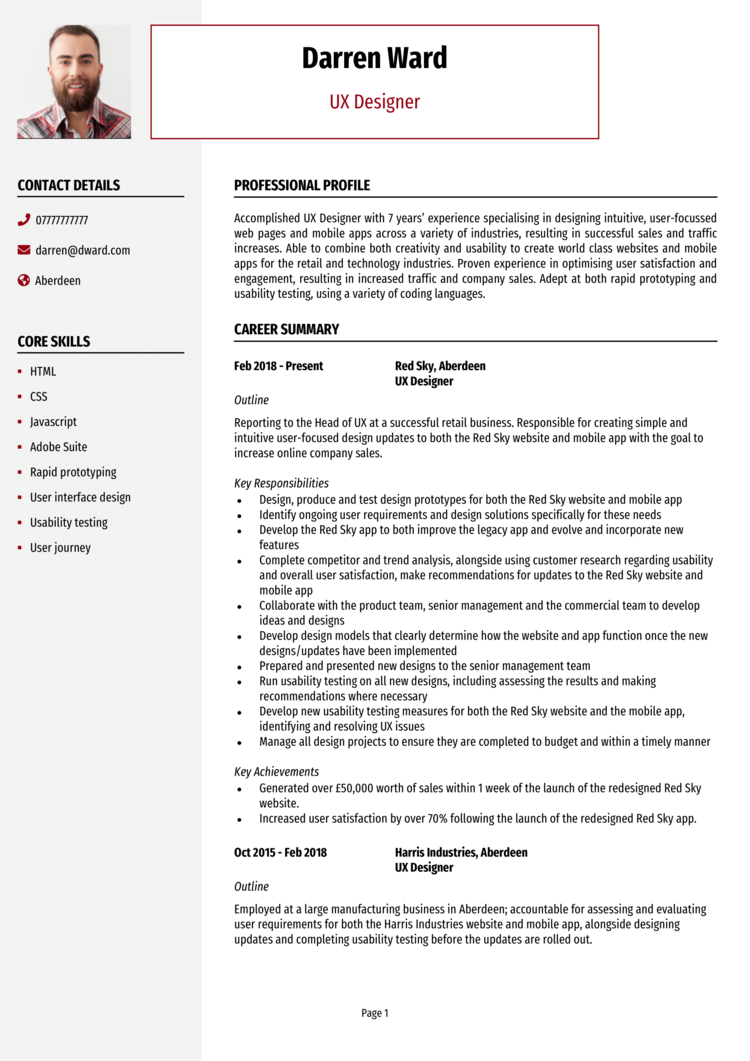
The above CV example demonstrates the type of info you should be including within your UX designer CV, as well as how to display this information in a way which looks professional and is easy for time-strapped recruiters to read.
This is the standard you should be aiming for, so remember to refer back to it throughout the CV writing process.
UX designer CV structure and format
Think your CV is just about words? Think again.
Your CV needs to look professional and be easy for recruiters to read, meaning the structure and format of your CV are equally as important as the content within it.
Facilitate ease of reading by working to a simple structure which allows recruiters to easily navigate your experience.

Formatting Tips
- Length: Whether you’ve got one year or three decades of experience, your CV should never be more than two sides of A4. Recruiters are busy people who’re often juggling numerous roles and tasks, so they don’t have time to read lengthy applications. If you’re a recent graduate or don’t have much industry experience, one side of A4 is fine.
- Readability : Help out time-strapped recruiters by formatting your CV for easy reading. Using lots of bullet points and lists will help them to skim through your info, while clearly formatted headings will allow them to navigate towards the content which is most useful to them.
- Design: The saying ‘less is more’ couldn’t be more applicable to CVs. Readability is key, so avoid overly complicated designs and graphics. A subtle colour palette and easy-to-read font is all you need!
- Avoid photos: Ditch logos, images or profile photos. Not only do they take up valuable space, but they may even distract recruiters from your important written content.

Structuring your CV
As you write your CV , divide and sub-head into the following sections:
- Name and contact details – Always start with these, so employers know exactly how to get in touch with you.
- CV profile – Add a short summary of your relevant experience, skills and achievements, which highlights your suitability.
- Core skills section – A 2-3 columned list of your key skills.
- Work experience – A detailed list of any relevant work experience, whether paid or voluntary.
- Education – An overview of your academic background and any training you may have completed.
- Hobbies and interests – A brief overview of your hobbies and interests, if they’re relevant (optional).
Now I’ll guide you through exactly what you should include in each CV section.
CV Contact Details

Kick-start your CV with your contact details, so recruiters can get in touch easily. Here’s what you should include:
- Mobile number
- Email address – Make sure it’s professional, with no silly nicknames.
- Location – Your town or city is sufficient, rather than a full address.
- LinkedIn profile or portfolio URL – Ensure they’ve been updated and are looking slick and professional.
Quick tip: Avoid listing your date of birth, marital status or other irrelevant details – they’re unnecessary at this stage.
UX designer CV Profile
Your CV profile (or personal statement , if you’re an entry-level applicant) provides a brief overview of your skills, abilities and suitability for a position.
It’s ideal for busy recruiters and hiring managers, who don’t want to waste time reading unsuitable applications.
Think of it as your personal sales pitch. You’ve got just a few lines to sell yourself and prove you’re a great match for the job – make it count!

Tips for creating an impactful CV profile:
- Keep it brief: When it comes to CV profile length, less is more, as recruiters are often time-strapped. Aim for around of 3-5 persuasive lines.
- Tailor it: Recruiters can spot a generic, mass-produced CV at a glance – and they certainly won’t be impressed! Before you write your profile (and CV as a whole), read through the job advert and make a list of any skills, knowledge and experience required. You should then incorporate your findings throughout your profile and the rest of your CV.
- Don’t add an objective: Want to talk about your career goals and objectives? While the profile may seem like a good space to do so, they’re actually much better suited to your cover letter .
- Avoid cliches: Clichés like “ blue-sky thinker with a go-getter attitude” might sound impressive to you, but they don’t actually tell the recruiter much about you. Concentrate on highlighting hard facts and skills, as recruiters are more likely to take these on board.
What to include in your UX designer CV profile?
- Summary of experience: To give employers an idea of your capabilities, show them your track record by giving an overview of the types of companies you have worked for in the past and the roles you have carried out for previous employers – but keep it high level and save the details for your experience section.
- Relevant skills: Employers need to know what skills you can bring to their organisation, and ideally they want to see skills that match their job vacancy. So, research your target roles thoroughly and add the most important UX designer skills to your profile.
- Essential qualifications: Be sure to outline your relevant UX designer qualifications, so that anyone reading the CV can instantly see you are qualified for the jobs you are applying to.
Quick tip: If spelling and grammar are not a strong point of yours, Use our quick-and-easy CV Builder to add pre-written content that has been created by recruitment experts, and proofread by our team.
Core skills section
Underneath your profile, create a core skills section to make your most relevant skills jump off the page at readers.
It should be made up of 2-3 columns of bullet points of your relevant skills.
Before you do this, look over the job description and make a list of any specific skills, specialisms or knowledge required.
Then, make sure to use your findings in your list. This will paint you as the perfect match for the role.

Work experience/Career history
By this point, employers will be keen to know more detail about you career history.
Starting with your most recent role and working backwards, create a snappy list of any relevant roles you’ve held.
This could be freelance, voluntary, part-time or temporary jobs too. Anything that’s relevant to your target role is well-worth listing!

Structuring your roles
Your work experience section will be long, so it’s important to structure it in a way which helps recruiters to quickly and easily find the information they need.
Use the 3-step structure, shown in the below example, below to achieve this.

Start with a 1-2 sentence summary of your role as a whole, detailing what the goal of your position was, who you reported to or managed, and the type of organisation you worked for.
“Responsible for creating simple and intuitive user-focused design updates to both the Red Sky website and mobile app with the goal to increase online company sales.”
Key responsibilities
Use bullet points to detail the key responsibilities of your role, highlighting hard skills, software and knowledge wherever you can.
Keep them short and sharp to make them easily digestible by readers.
- Design, produce and test design prototypes for both the Red Sky website and mobile app
- Identify ongoing user requirements and design solutions specifically for these needs
- Develop the Red Sky app to both improve the legacy app and evolve and incorporate new features
Key achievements
To finish off each role and prove the impact you made, list 1-3 stand out achievements , results or accomplishments.
This could be anything which had a positive outcome for the company you worked for, or perhaps a client/customer. Where applicable, quantify your examples with facts and figures.
- Generated over £50,000 worth of sales within 1 week of the launch of the redesigned Red Sky website
- Increased user satisfaction by over 70% following the launch of the redesigned Red Sky app
Next up, you should list your education and qualifications.
This can include your formal qualifications (a degree, A-Levels and GCSEs), as well as sector-specific UX designer qualifications and/or training.
While school leavers and recent grads should include a lot of detail here to make up for the lack of work experience, experienced candidates may benefit from a shorter education section, as your work experience section will be more important to recruiters.
Interests and hobbies
The hobbies and interests CV section isn’t mandatory, so don’t worry if you’re out of room by this point.
However, if you have an interesting hobby , or an interest that could make you seem more suitable for the role, then certainly think about adding.
Be careful what you include though… Only consider hobbies that exhibit skills that are required for roles as a UX designer, or transferable workplace skills. There is never any need to tell employers that you like to watch TV and eat out.
Essential skills for your UX designer CV
Tailoring your CV to the roles you are applying for is key to success, so make sure to read through the job descriptions and tailor your skills accordingly.
However, commonly desired UX designer skills include:
- Design and creativity – Demonstrate creative, intuitive design skills and how you use these effectively to improve user experience.
- Programming – You need a strong and broad base of programming skills to be able to trouble-shoot and solve issues.
- Self-development skills – Showcase your commitment to self-development in the context of the business’s needs, staying ahead of fast-moving trends and innovation.
- Project management – Explain how you manage project s with efficiency; managing budgets, time constraints and deadlines.
- Testing and analysis – Detail how you use testing, analysis and evaluation to ensure absolute understanding of user experience, rooted in UX research.
Writing your UX designer CV
When putting together your UX designer CV, there are a few key points to remember
Always tailor your CV to the target role, even if it means creating several versions for different roles.
Additionally, remember that the structure and format of your CV needs just as much attention as the content.
Remember to triple-check for spelling and grammar errors before hitting send. If you’re unsure, use our quick-and-easy CV Builder to add pre-written expert content with one click.
Good luck with your job search!
Megan Taylor
Personal statement.
When I was five years old I marched into my father’s study and announced “When I grow up I’m going to be Bill Nye the Science Guy!” Though I have yet to be solicited to host my own TV show, I like to think that I turned out quite a bit like my childhood idol. I have made it my mission to share my scientific knowledge with the world by designing and building technologies that directly improve the quality of people’s everyday lives. I also happen to act and dance on the side, so if you are scouting for the next Bill Nye to compete in Dancing with the Stars, be sure to remember my name.
In regards to my professional goals, I stumbled upon the department of Human Centered Design and Engineering during my second quarter at the University of Washington. Originally admitted to the department of Civil and Environmental Engineering, I was quickly captivated by the many doors that HCDE offered to open. The HCDE curriculum allowed me to pursue philosophy and other humanities classes, which I value as a part of a well-rounded education. It also promised to provide me with the skills in user research, user experience, project management and programing that have become so applicable in our technology driven society.
As someone deeply passionate about inclusion and disability advocacy, this new educational track was an opportunity to connect multiple areas of my life. I made the switch to HCDE and, with me, I brought the expansive perspective that results from growing up with a disabled older brother. In turn, I feel that my personal experiences have especially prepared me for a future in product design and user experience. Whenever I approach a design problem, I prioritize perspectives that are often forgotten or overlooked by the general public. For example, when I analyze the user interface on a modern microwave, I may find it extremely effective for my own purposes. However, not everyone has the same set of needs. The buttons on most microwaves are built flat into the surface of the device, so a blind user who requires tactile feedback would be unable to navigate the control panel. In this light, I maintain that integrating tactile and audio feedback into everyday products would greatly extend the range of usability for not only blind users, but also the elderly and vision impaired. Accordingly, I am excited by the prospect of running and conducting usability research in order to discern how technology can be utilized to satisfy the full range of human needs, especially with consideration to the disabled community. I am confident that, when I graduate with my masters in HCDE or HCI, I will have the technical and commutative skill required to flourish in the workplace, as well as the drive and inspiration needed to lead a long and happy life.

- Copy shortlink
- Report this content
- Manage subscriptions

5 Ways to Build a Successful UX Personal Brand
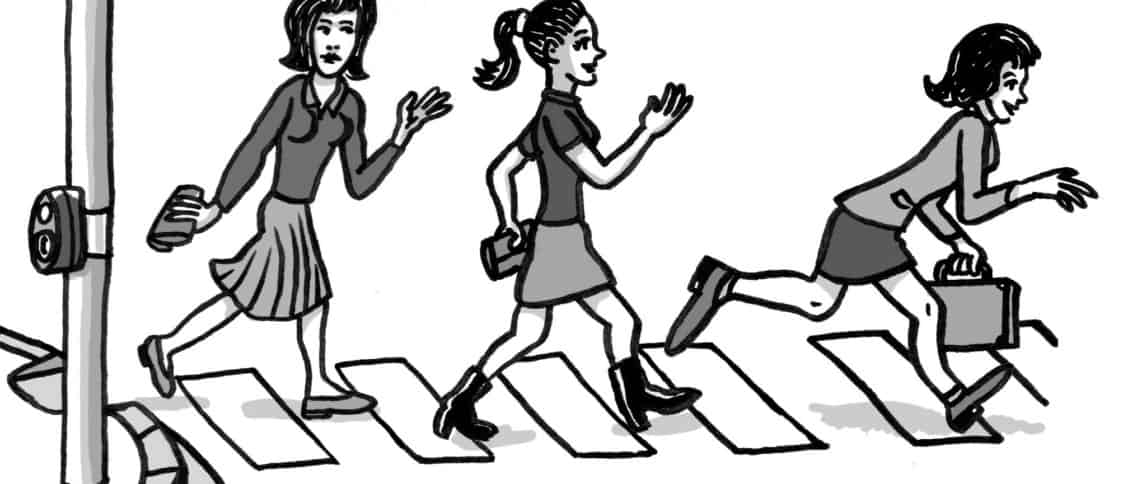
Whether we like it or not, every single one of us is a brand. What we do with our brand enables us to shape our UX careers in ways we may not have considered. Ashlea McKay built hers by accident, but along the way, she learned how to apply her thinking in a structured way. Here are five ways to build a successful personal brand in UX and create your own career destiny.
I used to think that ‘personal brand’ was a dirty word (or two).
Until I woke up one day and realised I had become one and it wasn’t so bad. In fact, it wasn’t bad at all – it was great!
It all started in June 2014. I was almost three years into my career and I was caught in the middle of a hiring freeze. I was a junior designer at a government department and was eager to advance to more challenging roles. But like everyone else working in government, I was stuck. In order to grow as a professional, I had to get creative.
At the time, I had just completed my first remote test of an information architecture using Optimal Workshop’s remote tree testing tool, Treejack. My very supportive manager encouraged me to write a blog post on my experiences to share my tips and advice for using the tool. I was sceptical at first but I did it anyway, and one day in a moment of brazen audacity, I decided to tweet my blog to Optimal Workshop .
Three days later I received an email from them – they loved it. Even better, they wanted me to write for them! Everything snowballed from there. Doors opened, opportunities flourished, and I discovered things I had never imagined possible.
In less than twelve months, I went from having zero presence in UX to experienced UXers referring to me as a ‘highly respected industry thought leader’. This was followed by speaking engagement offers, conference appearances, an eBook and several articles. My whole world expanded exponentially and to this day, that growth isn’t showing any signs of slowing down.
Whether we like it or not, every single one of us is a brand. What we do with our brand enables us to shape our UX careers in ways we may not have considered. I built mine by accident, but along the way, I learned how to apply my thinking in a structured way. Here are five ways to build a successful personal brand in UX and create your own career destiny.
Know what you stand for and live it
We have to talk about this one up front, because the other four points will fall over if you don’t address this first. Who you are and what you care about lie at the very heart of your personal brand. Your values and how you live them affect the way you see the world and the ways others see you.
Take some time out today to jot down what matters to you. Brainstorm as many values as you can, then choose 4-6 that you feel closest to. It’s not about coming up with buzzwords or changing who you are – it’s about unearthing what’s already there so you can ensure that your blogs, social media presence and your other actions reflect who you are.
To help you get started, here are mine:
- Authenticity
- Perseverance
They’re really just labels of what I’ve been living these past 30 years, but putting names to them helps me stay focused. As life happens and your career (and thinking) evolves, your values and perspectives may change. That’s ok too, so don’t feel like you’re stuck with them forever.
Start blogging
I’ll let you in on a secret. When I’m writing, I’m mostly just scribing exactly what’s bouncing around in my head. There’s no formula or structured approach to it, I just record what I’m thinking in words and I write the way I speak.
Once all my thoughts are out of my head and on the screen, I edit. That’s when the real magic happens. I organise and structure the information in a way that makes sense and tells a story – fundamental UX skills we all have. You don’t have to be an amazing writer to start blogging. All you need is an idea or an opinion, and you know what they say about those!
Write about things you’ve learned, people you’ve met, bad UX, great UX, UX that isn’t digital. Whatever makes you happy, sad or annoyed: write about it. You could start your own UX blog or you could publish posts as part of your online portfolio. Publishing to LinkedIn or Medium are both easy entry points.
Go to meetups and networking events
Get your face out there and meet other awesome UX people. Networking is not about using people or making it rain business card style at every event you attend. It’s about connecting with other human beings, giving back and learning along the way.
Every new introduction is a chance to grow and learn. You never know what opportunities will come your way or how you might be able to help them. The UX community is an ecosystem, and as cliched as it sounds, every little ripple helps us all.
Develop a social media presence
A meaningful social media presence is a must when building a personal brand in your UX career. It’s your digital professional voice and it must be heard – Twitter and LinkedIn are my top picks platform-wise.
By meaningful, I mean a social media presence that’s relevant to your personal UX brand. You can still be a human being who tweets pictures of exceptionally well-plated food and those shoes you bought on sale for an absolute steal, but try to keep at least 75% of your content in the realm of professional publishing. Share and start a discussion about the latest book or article you’ve read or strike up a conversation with someone you admire.
Actively putting your hand up for UX volunteer opportunities is one of the best ways to try something that you might not get to do in your regular job. A few years ago, UX Mastery was running a UX Careers Panel discussion at UX Australia Redux 2014 in Melbourne. They were short a panel member, and when they put out a call for help on social media, I jumped at the chance.
I was working in that junior role I mentioned earlier and I had no public speaking experience, but I didn’t let that stop me. I saw it as a nice safe environment for me to practice my speaking skills, spend time with my UX Mastery friends, meet new people and have my voice heard.
The exposure I gained through that panel appearance led to two conference talks (one was overseas) which in turn, led to even more talks. Put your hand up and you never know what will happen.
Know what you stand for, blog, network, use social media wisely and put your hand up for UX opportunities are the key elements to building a strong personal brand for your UX career. Not exactly groundbreaking stuff, but when applied together and in the right way, can result in a lasting positive impact.
What tactics have you used to build up your UX personal brand? Leave a comment or let us know in the forums.
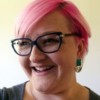
Ashlea McKay
Ashlea is a UX Designer and Researcher based in Canberra, Australia. She spends her days conducting user research studies, facilitating usability evaluations, analyzing and interpreting results, and creating kick-ass reports on her findings.
Ashlea is passionate about design training and in her spare time mentors new designers in her workplace and through online communities.
Join the discussion Cancel reply
Very good read Ashlea, thank you for sharing your process, thoughts and tips. Your words give me affirmation as an aspiring UX professional, I am starting off on the right track. Thank you!
Love your article and your put it out there mindset
That’s really awesome UX tips. I will definitely use this for my project. I hope that you will continue sharing this type of content for beginners in this field. Regards, Andy
Further reading

Bad UX Examples: A Guideline to Prevent Errors
Achieving a great User Experience (UX) is essential in the digital space world. Good UX design connects with users. Yet, one can encounter dozens of...

The Difference Between A Product Designer and UX Designer
Are you interested in building a career in UX (User Experience) Design? While scouting UX design job boards, you’ve likely come across a...
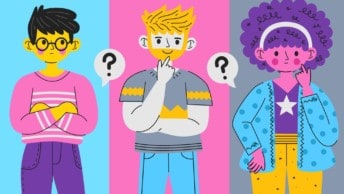
When WordPress Is Not a Good Solution for Your Website (and Best Alternatives)
WordPress is a popular tool (and rightly so) for most people. However, there may be times when it is not the right fit for your work. Knowing which...

Follow @uxmastery

UI/UX Designing Articles

Get In Touch For Details! Request More Information

8 UX Designer Resume Examples and Portfolio Guide
Apr 02, 2024 3 Min Read 710 Views
(Last Updated)
The journey to landing your dream job as a UX designer begins with a powerful tool: your resume.
The key is to understand what companies seek in potential employees. Skills, qualifications, and specific information are vital components that employers focus on. But how do you craft a resume that stands out? How do you design it to catch the eye of hiring managers?
This blog answers these questions, providing some inspiring UX designer resume examples with insights and also emphasizing portfolio creation so you can effectively showcase your talents and formulate a compelling narrative that resonates with your dream employers.
Table of contents
- UX Designer Resume Examples: How Should You Design It?
- UX Designer Portfolio Examples: Showcasing Your Body of Work
- Creating a Stunning UX Designer Resume: 4 Key Components to Consider
- Frequently Asked Questions (FAQs)
- How long should a UX designer's resume be?
- What kind of projects should I include in my UX design portfolio?
- Can I include freelance projects in my UX design portfolio?
- Should a UX design resume include a personal statement?
- How do I showcase soft skills in a UX design resume?
A well-designed UX designer resume should encapsulate several key elements . Firstly, it should reflect your understanding of your audience, acknowledging that your resume might pass through various hands, from non-technical staff to seasoned UX professionals.
Highlighting relevant skills and tailoring your resume to match specific job postings is crucial. Avoid common pitfalls such as typos, inconsistent designs, and outdated information. Prioritize information logically, with your most recent and relevant experiences taking precedence.
Also, Learn the Top 12 Key UI/UX Design Principles
To give you a clearer picture, here are some UX designer resume examples that encapsulate these principles:
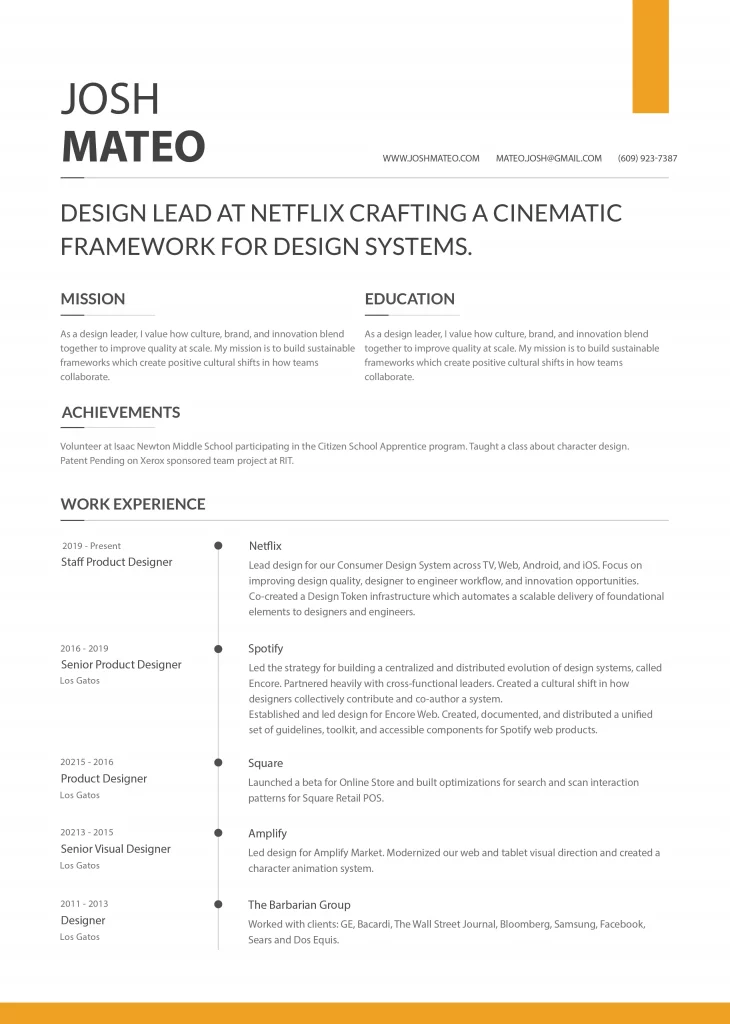
Design Lead – Netflix
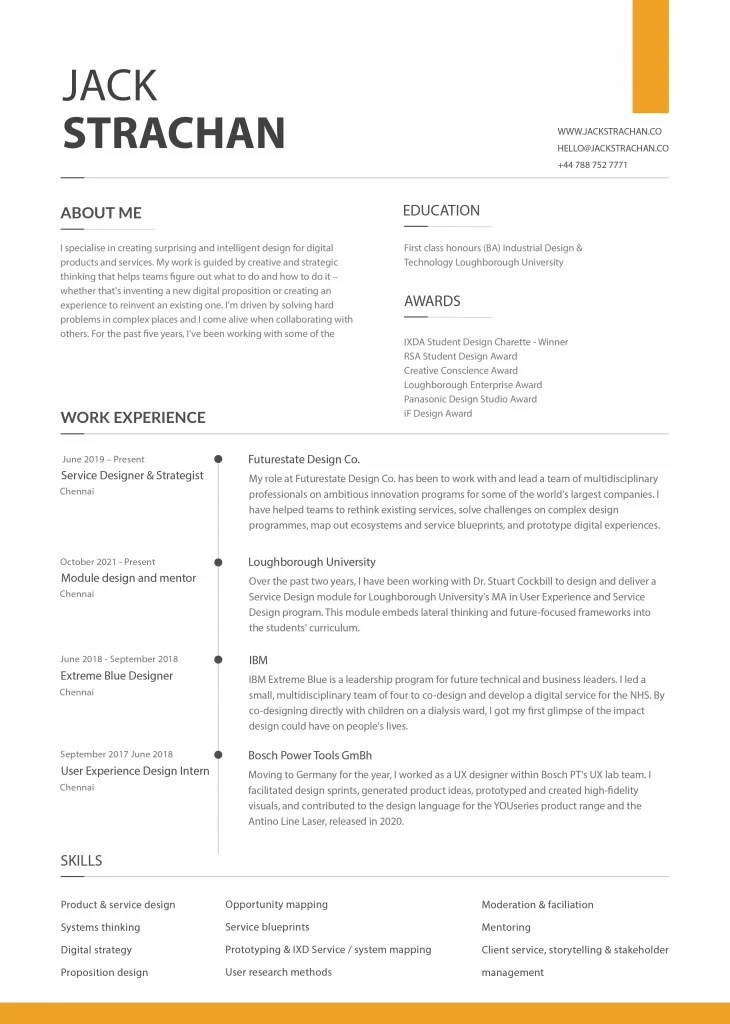
Jack Strachan
Service Service Designer – HM Revenue & Customs
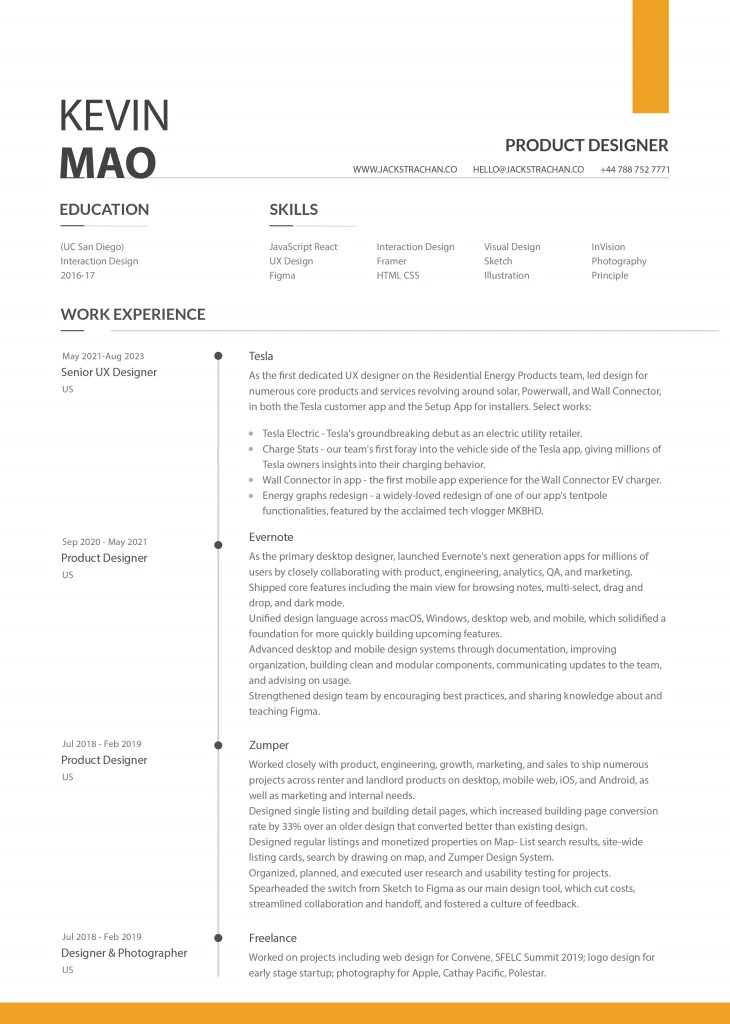
Senior UX Designer – Tesla
As we proceed to the next phase, make sure you understand the fundamentals of UI/UX, which includes heuristic analysis, journey maps, testing, etc. If you want to explore more about it, join GUVI’s UI/UX Career Program with Placement Assistance . You’ll also learn about the tools used in UI/UX which are AdobeXD, Illustrator, Photoshop, Figma, and many more. Build some amazing real-time projects to get hands-on experience.
Also, if you want to explore Figma through a Self-paced course, try GUVI’s Figma Self-Paced certification course .

Your portfolio is equally critical in showcasing your expertise and eye for detail. It should complement your resume, providing a more in-depth look at your UX design skills and philosophy .
Here are five outstanding UX designer portfolio examples that demonstrate creativity, technical skill, and an understanding of user-centric design:
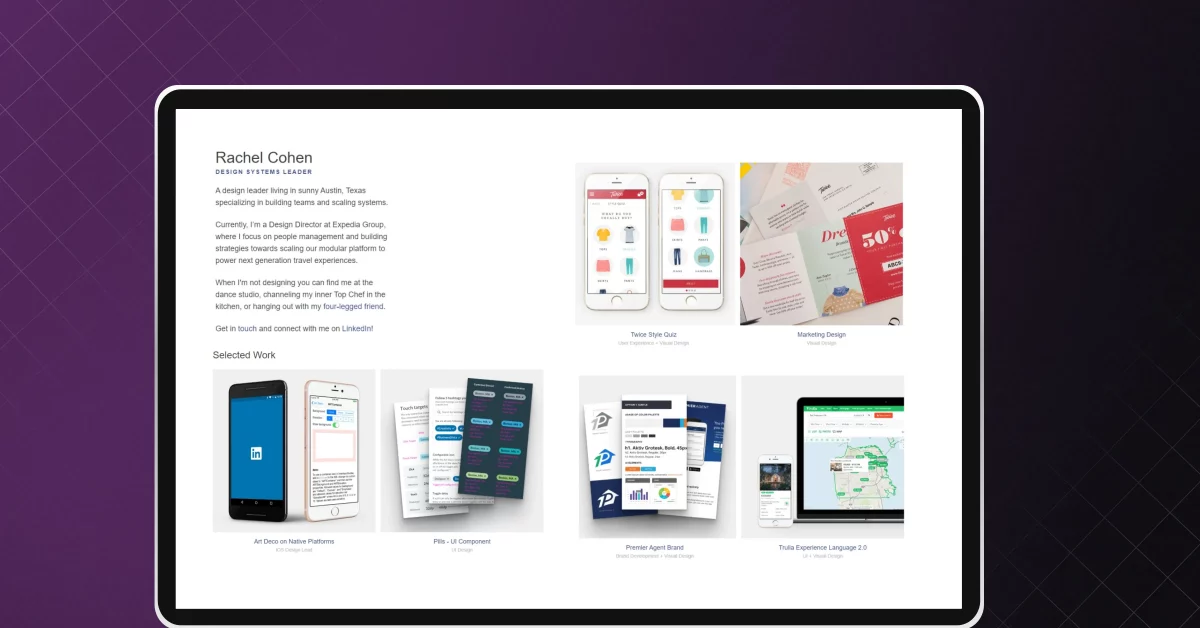
Rachel Cohen
Director of Design Infrastructure – GitHub
See her full portfolio
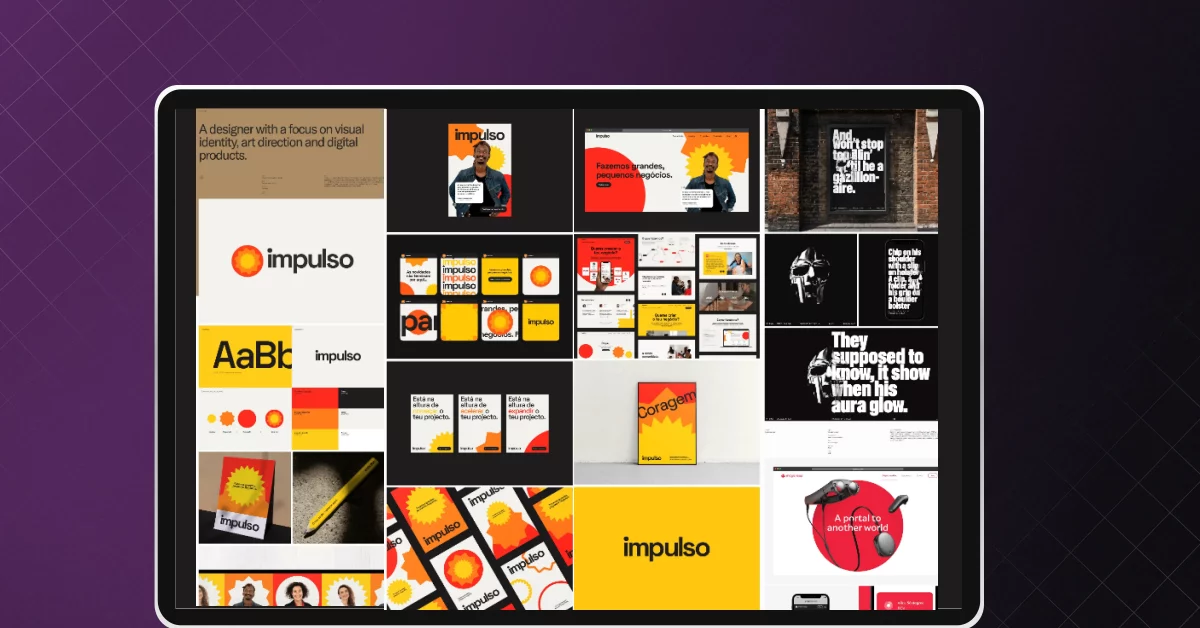
Design Lead – Work & Co
See his full portfolio

Shawn Roberts Jr.
Product Designer – Uber
See full portfolio

Senior Staff Design Strategist – Google

Product Manager – Zoom
Find out 12 Unique UI/UX Project Ideas to Boost Your Portfolio
As you may have noticed in the UX designer resume examples, four essential components play a pivotal role in crafting an effective and visually appealing UX design resume. These components include:
- Typefaces : Choose up to two highly readable typefaces with a medium stroke weight, avoiding handwriting or novelty fonts. Opt for simple serifs or sans serifs for clarity and professionalism.
- Whitespace : Utilize ample whitespace between elements and sections to create a natural, flowing layout. This spacing enhances the visual distinction between different sections and improves overall readability.
- Color : Aim for a classic look with black text on a white background, ensuring easy and consistent printing, even in black and white. If using color accents, select a hue that is readable and prints well on standard copy paper, even in grayscale.
- Readability : Pay attention to line length, phrase breaks, and contrast. These elements are crucial in making your resume scannable, allowing readers to quickly identify key information and understand your professional story at a glance.
Kickstart your UI/UX journey by enrolling in GUVI’s UI/UX Career Program where you will master technologies like AdobeXd, Illustrator, and Figma, and build interesting real-life UI/UX projects.
Alternatively, if you would like to explore Figma through a Self-paced course, try GUVI’s Figma’s Self-Paced certification course .
The qualities that make you an exceptional UX designer are the same ones that can help you craft an outstanding resume.
Think about your resume as a project in user experience design – consider your audience and how they will interact with your resume. A successful UX designer resume combines a clear hierarchy of information with relevance to the position, ensuring it’s easy to read and immediately showcases your skills.
While the format may differ from what you’re used to in design, it’s an opportunity to demonstrate your expertise in a unique and impactful way. We hope the UX design resume examples we have shared, along with UX design portfolio examples, give you the right direction.
Explore GUVI’s UI UX Design Career Program with Placement Assistance. Enroll in our UI UX program which is designed by industry experts with keeping you in mind.
If you find this article helpful, read our in-depth guide on UI/UX project showcase and its importance.
How long should a UX designer’s resume be?
A UX designer’s resume should ideally be one page, focusing on relevant experience and skills.
You can include a variety of projects that showcase different skills, such as wireframes, user research, and final designs.
Yes, freelance projects are valuable in showing diverse experience and practical skills.
A brief personal statement can be included, focusing on your design philosophy and career goals.
You can include instances where soft skills like teamwork, communication, and problem-solving were crucial in projects.
Career transition
About the Author
Saanchi Bhardwaj
I'm a passionate writer fueled by my love for English literature and the vast world of creative arts. You can find me at GUVI, where I write informative articles offering detailed solutions to common problems.
Did you enjoy this article?
Recommended courses.
- Career Programs
- Micro Courses

Most Popular

UI/UX Design course
Available in
EMI Options Available
Placement Guidance
1:1 Mentor Doubt Clearing Sessions
UX Fundamentals

Design Guidelines using Figma

UI Fundamentals

Mastering Figma: Beginner to Expert UI/UX Design
Schedule 1:1 free counselling
Similar Articles
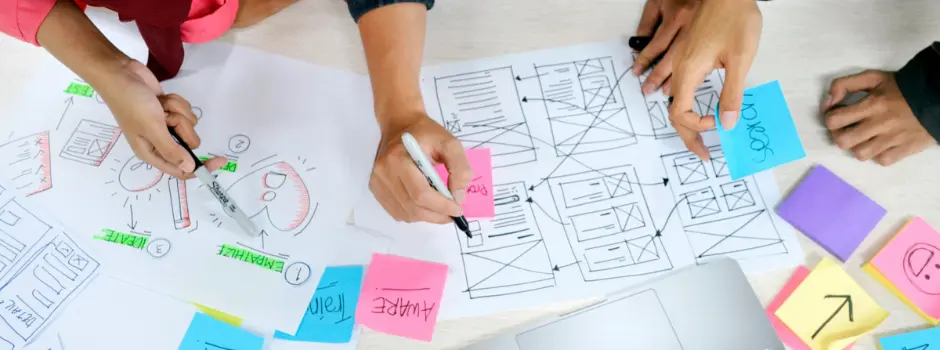
By Saakshi Priyadarshini
24 Apr, 2024
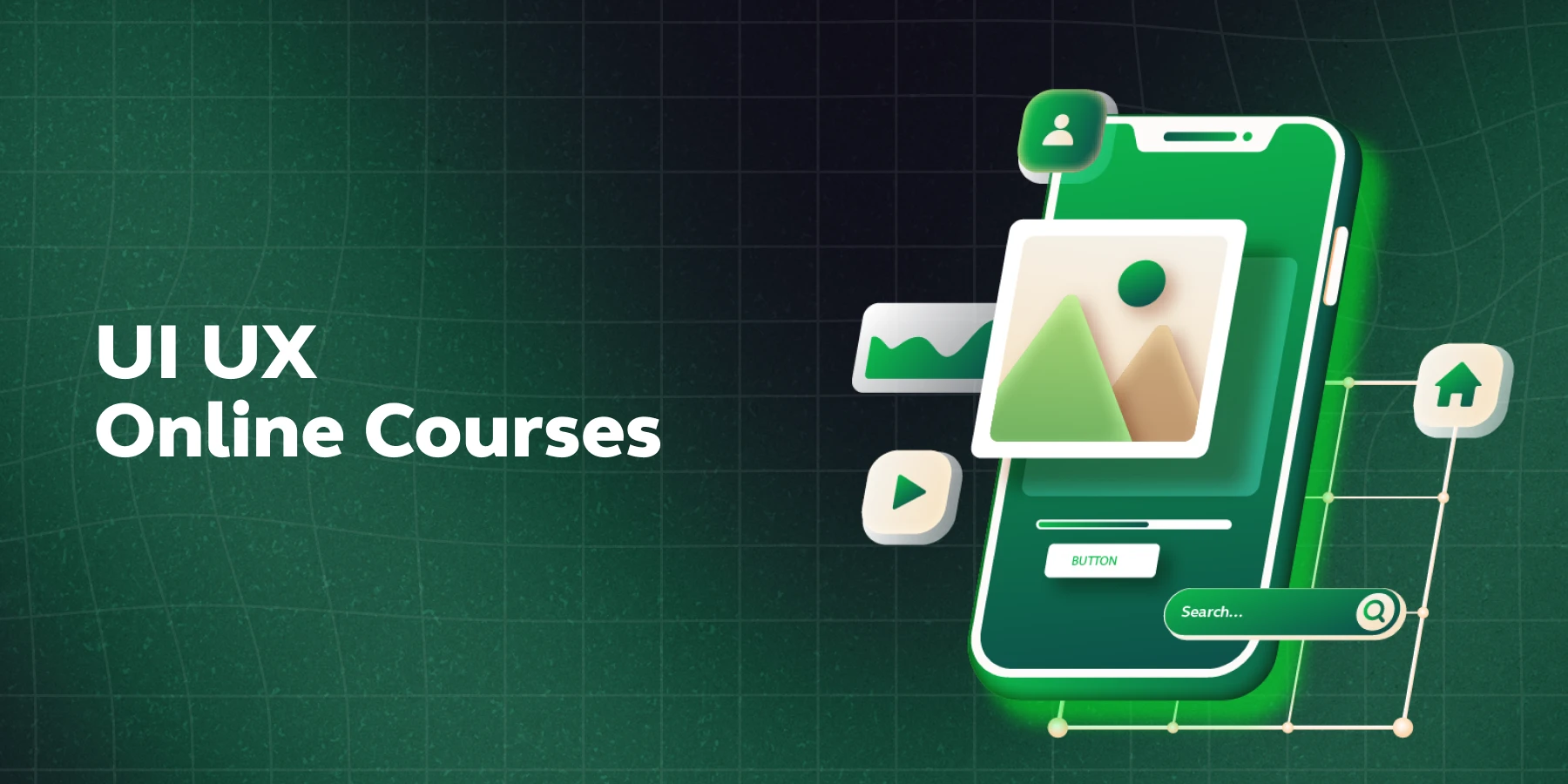
By Saanchi Bhardwaj
20 Apr, 2024
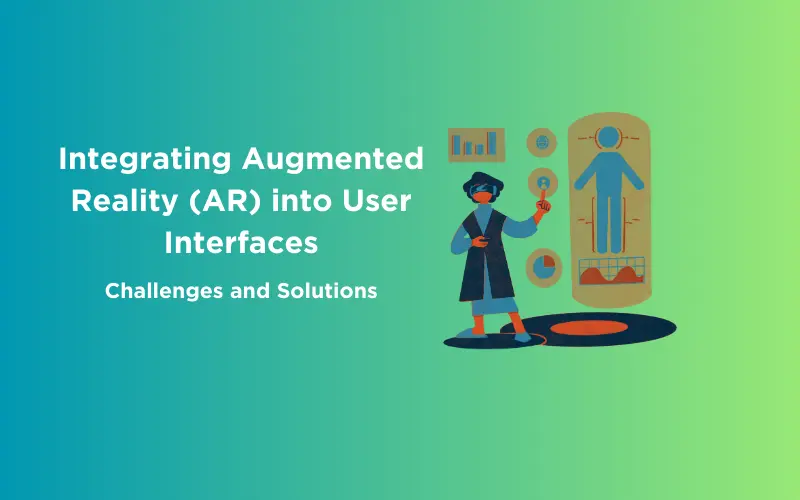
By Meghana D
16 Apr, 2024

By Isha Sharma
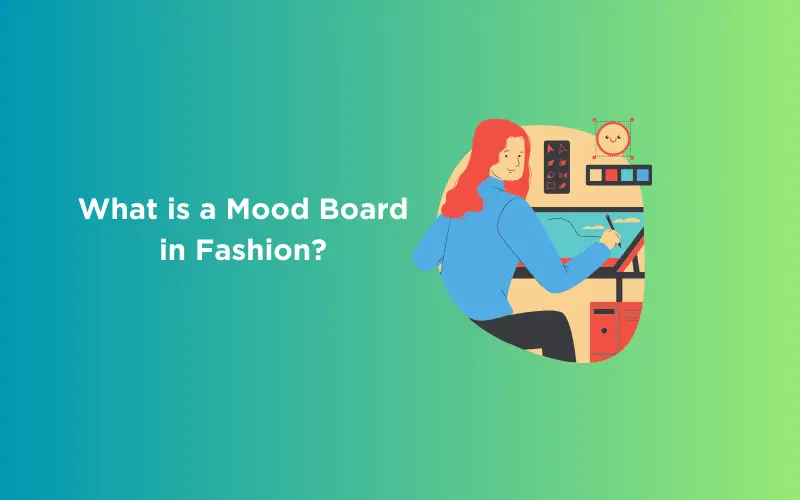
By Jaishree Tomar
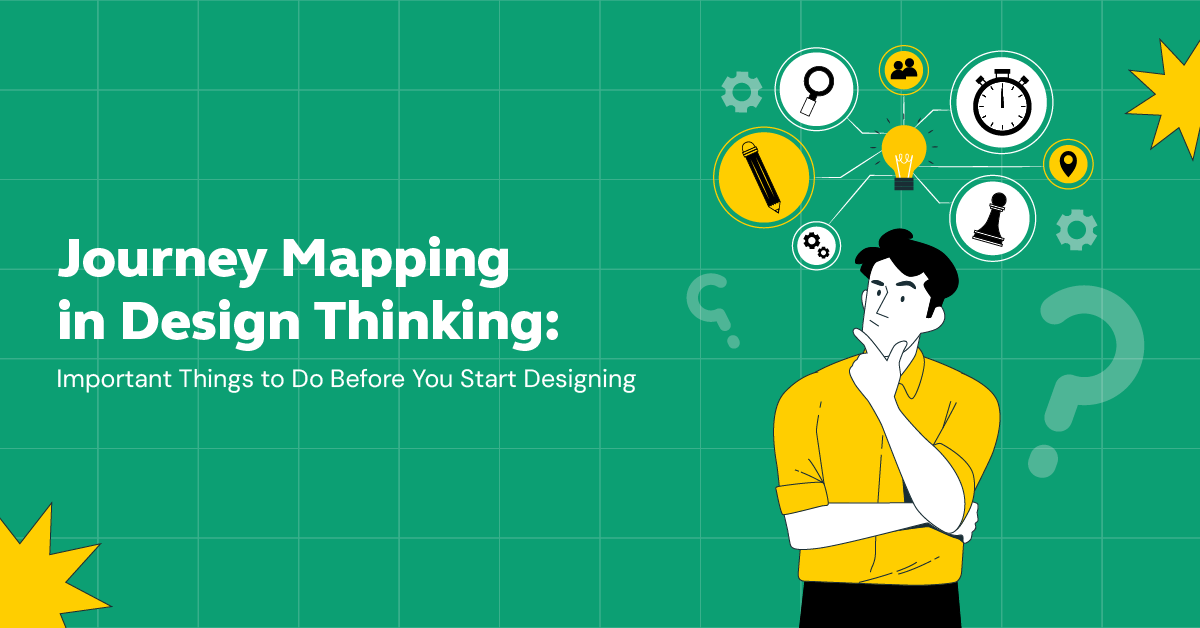
By Lukesh S
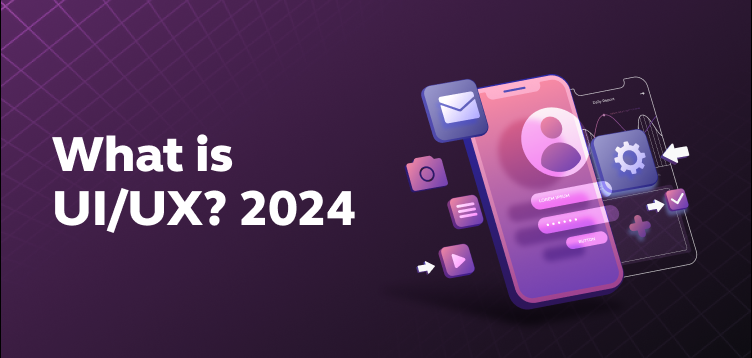
- How It Works
- United States
- View all categories
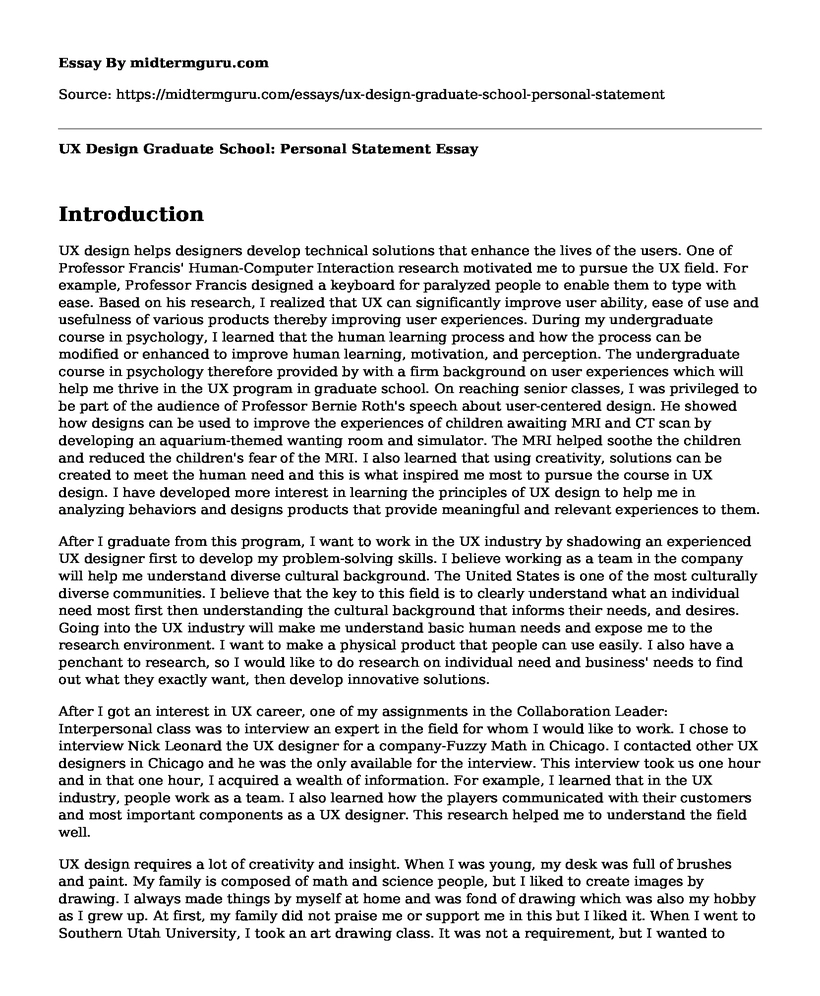
UX Design Graduate School: Personal Statement
Introduction.
UX design helps designers develop technical solutions that enhance the lives of the users. One of Professor Francis' Human-Computer Interaction research motivated me to pursue the UX field. For example, Professor Francis designed a keyboard for paralyzed people to enable them to type with ease. Based on his research, I realized that UX can significantly improve user ability, ease of use and usefulness of various products thereby improving user experiences. During my undergraduate course in psychology, I learned that the human learning process and how the process can be modified or enhanced to improve human learning, motivation, and perception. The undergraduate course in psychology therefore provided by with a firm background on user experiences which will help me thrive in the UX program in graduate school. On reaching senior classes, I was privileged to be part of the audience of Professor Bernie Roth's speech about user-centered design. He showed how designs can be used to improve the experiences of children awaiting MRI and CT scan by developing an aquarium-themed wanting room and simulator. The MRI helped soothe the children and reduced the children's fear of the MRI. I also learned that using creativity, solutions can be created to meet the human need and this is what inspired me most to pursue the course in UX design. I have developed more interest in learning the principles of UX design to help me in analyzing behaviors and designs products that provide meaningful and relevant experiences to them.
Is your time best spent reading someone else’s essay? Get a 100% original essay FROM A CERTIFIED WRITER!
After I graduate from this program, I want to work in the UX industry by shadowing an experienced UX designer first to develop my problem-solving skills. I believe working as a team in the company will help me understand diverse cultural background. The United States is one of the most culturally diverse communities. I believe that the key to this field is to clearly understand what an individual need most first then understanding the cultural background that informs their needs, and desires. Going into the UX industry will make me understand basic human needs and expose me to the research environment. I want to make a physical product that people can use easily. I also have a penchant to research, so I would like to do research on individual need and business' needs to find out what they exactly want, then develop innovative solutions.
After I got an interest in UX career, one of my assignments in the Collaboration Leader: Interpersonal class was to interview an expert in the field for whom I would like to work. I chose to interview Nick Leonard the UX designer for a company-Fuzzy Math in Chicago. I contacted other UX designers in Chicago and he was the only available for the interview. This interview took us one hour and in that one hour, I acquired a wealth of information. For example, I learned that in the UX industry, people work as a team. I also learned how the players communicated with their customers and most important components as a UX designer. This research helped me to understand the field well.
UX design requires a lot of creativity and insight. When I was young, my desk was full of brushes and paint. My family is composed of math and science people, but I liked to create images by drawing. I always made things by myself at home and was fond of drawing which was also my hobby as I grew up. At first, my family did not praise me or support me in this but I liked it. When I went to Southern Utah University, I took an art drawing class. It was not a requirement, but I wanted to learn about art and truly enjoyed it. I did well in the class, and I got a recommendation from my teacher, Professor Brown. I also got an art recommendation letter from my high school teacher. The most interesting part of this class was to look at an object and use my own creativity to add value to it in my drawing. The result of the drawing will be not just an object itself, but it was an abstract drawing creatively designed to improve aesthetics. I believed that the apart from the fun of creative part in art, the class had the potential to help me with learning the UX principles.
I began to think more deeply about different human behaviors and motivation when I was in high school. I realized through direct experience of how motivation affects my behavior. I went to high school in Canada for about 10 months and their education system in Canada was very different from the way of education in Korea. Their education systems motivated my interest in studying. For example, teachers in Canada focused on students who cannot follow their subjects well or speak English well. They taught me how to study systematically. After developing my interests in studying, I maintained a score of 90 to 100 in math, art. My scores in other subjects also greatly improved. I realized how human motivation is strong and has the potential of affecting human behavior. This experience made me study more in Psychology about human behavior and motivation.
From my experiences with mitigation and behaviors, I developed an interest in understanding the relationship between user experiences and behaviors change based on the Transtheoretical Model. I decided to pursue my studies in the U.S.A. In the process of obtaining my bachelor's degree in Psychology and a minor in Sociology, I was exposed to the research field. I worked as a research assistant at Yonsei University in South Korea and I enjoyed this position. I even conducted an experiment and learned the whole research process. It is from the experience that I decided to look for a research assistant position when I return to Purdue University. I initially contacted Professor Francis and worked as a research assistant for 1 year during which we investigated the visual percepts for the moon. Since this was a natural experiment, we could not control many variables. Our research was unique since it was not in the laboratory but it was outside the experiment. Thus, I had to run the experiment early in the morning, middle of the day, and later in the night. I ran the experiments and found an appropriate location for the experiment successfully. Right now we are in the final stages of preparing our research report to be published in a reputable journal. I managed many participants and this led me to learn important value of leadership and responsibility. Working with lab partner helped me develop my teamwork skills. I learned the best practices of research experiments and these experiences motivated me to look for a graduate school like yours to study more.
Cite this page
UX Design Graduate School: Personal Statement. (2022, Nov 07). Retrieved from https://midtermguru.com/essays/ux-design-graduate-school-personal-statement
so we do not vouch for their quality
If you are the original author of this essay and no longer wish to have it published on the midtermguru.com website, please click below to request its removal:
- Essay on The UK Museum Documentation Standard by McKenna and Patsatzi
- Visual Analysis of a Museum Object: Lekythos
- Film Analysis Essay on the Salt of the Earth
- Paper Example on Media's Positive Effect on the LGBTQ Community
- Freedom of Speech: Right to Express Without Restriction - Research Paper
- Free CeCe - Movie Analysis Essay
- Movie Analysis Essay on "The Secret Life of Babies"
Liked this essay sample but need an original one?
Hire a professional with VAST experience!
24/7 online support
NO plagiarism
Submit your request
Sorry, but it's not possible to copy the text due to security reasons.
Would you like to get this essay by email?
Interested in this essay?
Get it now!
Unfortunately, you can’t copy samples. Solve your problem differently! Provide your email for sample delivery
By clicking “I want to recieve an essay” you agree to be contacted via email
Sample is in your inbox
Avoid editing or writing from scratch! Order original essay online with 25% off. Delivery in 6+ hours!
- Reviews / Why join our community?
- For companies
- Frequently asked questions
Tips for Writing a CV for a UX Job Application
It’s not really fair that before we can show an interviewer how great we are for their position – we have to land that interview in the first place. A good CV can make or break your career prospects; you cannot get a great job without getting an interview. Sadly, in nearly all professions including UX many CVs are simply not fit-for-purpose.
Why do You Need a CV?
This is fairly obvious. A CV is a tool for opening doors to opportunities. It has to create the right impression on the person reading it for them to put you on their “possible hire” pile. Without that impact your CV is going straight into the circular file under someone’s desk and the door to a better job remains resolutely closed.
A CV needs to show a little of your personality, it has to demonstrate you have what it takes to do the job, it should offer an insight into what you bring a team and ideally, show a commitment to learning and personal development too
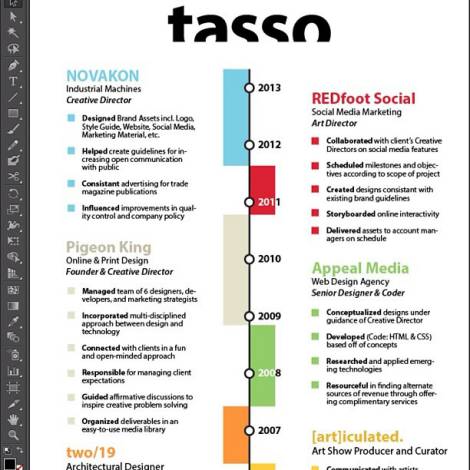
What Should a Good UX CV Contain?
There are some fairly simple rules to developing a great UX CV and these include:
Open With a Great Personal Statement
Your address and contact details belong at the end of a CV. You open the CV with the information that the recruiter really needs to see - your personal statement. This is where you get to tell the recruiter who you are and what you want to do and demonstrate your love for UX.
Keep sentences short. Use active verbs. Make bold and clear statements. This statement will go with your CV wherever it gets sent in the recruiting organization (unlike the cover letter which will often go in the bin following the first sift of CVs) – so make it work hard for you.
Keep it Short and To The Point
With the single exception of the contracting market (where it can be impossible to keep things very short); the rest of the recruiting world expects to see a CV of no more than 2 pages. If you can boil things down to a single page, without losing important information, so much the better. No-one needs to read a novel about your work life.
The longer your CV, the more likely it is that it will be thrown out because no-one can be bothered to read it. And let’s be fair; if you can’t summarize your career information well – how will you summarize research well?
Have a Logical Organized Format
I prefer to move from my personal statement to my experience to my education and then anything else I might (or might not) include such as interests and contact details. Each section is clearly defined and formatted for consistency. You don’t have to follow my flow but you do need to make it easy to access information and make it obvious where the reader can find the information that they need.
Consider Separating Experience from Work History
The truth is that most jobs in a linear career involve similar responsibilities and result in similar achievements . Instead of trying to stuff everything you’ve done in with every job and repeating a ton of stuff – why not just list your work history (one line per job) and then have an experience section listing your main achievements in life? It’s easier to read and far less tedious on a recruiter’s eye too.
Make Education Relevant
There’s nothing more ridiculous than a mid-career professional listing all their school subjects with grades against each. Nobody cares about what you did at school by the time you’re in a career – what they want to see is your professional development. Professional qualifications and your degree is more than enough in this section unless you’re hunting for your first job.
You can also stop listing every single module that made up your degree. Nobody cares about those either. A degree holds currency for about a year (if you’re lucky) after you’ve received it. After that – your studies become increasingly divorced from current practice in a field. So kill the list and free up that space to sell yourself better.

Interests and Hobbies
By and large, I’m not a fan of this section on a CV. When I’m hiring, I’m hiring people for what they can do for me and not the fact that they like to go abseiling on weekends. However, there are hiring managers out there that love this section.
If you’re going to use it. Be sparing – a line or two is enough. Don’t list banal data like “I like watching TV, reading books and listening to music.” Everyone does – it doesn’t make you interesting. Do include things that might make you stand out from the pile. “I am engaged in voluntary community work for a charity for the visually-impaired.”
What Shouldn’t a Good UX CV Contain?
There are some fairly simple rules about what you shouldn’t include on a CV too:
Obvious Typos
Look, the truth is your CV won’t go in the bin if there’s a mistake or even two on it but if there’s a mistake in every line – good bye. If you’re not the best writer in the world; get someone else to proofread your CV before it goes out the door. Attention to detail matters to employers.
No Explanation of Rapid Turnover of Work
My CV is full of 1 year (or less) assignments. That’s because I’m a contractor when I work for others – it’s for a set period of time and then I move onto something else. The only way people can know this is if I tell them. Employers aren’t keen on people with twenty recent moves on their CV without explanation; it sounds like you have no staying power.
Photos and Graphics
There are some job markets where a photo is an essential. In these markets choose a professional head shot and use that. Otherwise, don’t include photos, graphics, etc. on your CV. The more you stray from a traditional format – the less likely you are to be recruited. You may get noticed for use of these things but rarely will it impress anyone.
Writing a CV can be hard work but if you use the tips above; you’re much more likely to get the results you want from the exercise and that new UX job you’ve always wanted. Good luck.
How to Create a UX Portfolio

Get Weekly Design Tips
Topics in this article, what you should read next, how to change your career from graphic design to ux design.

- 1.4k shares
How to Change Your Career from Marketing to UX Design

- 1.1k shares
- 3 years ago
How to Change Your Career from Web Design to UX Design

The Ultimate Guide to Understanding UX Roles and Which One You Should Go For

How to write the conclusion of your case study

- 5 years ago
7 Tips to Improve Your UX Design Practice
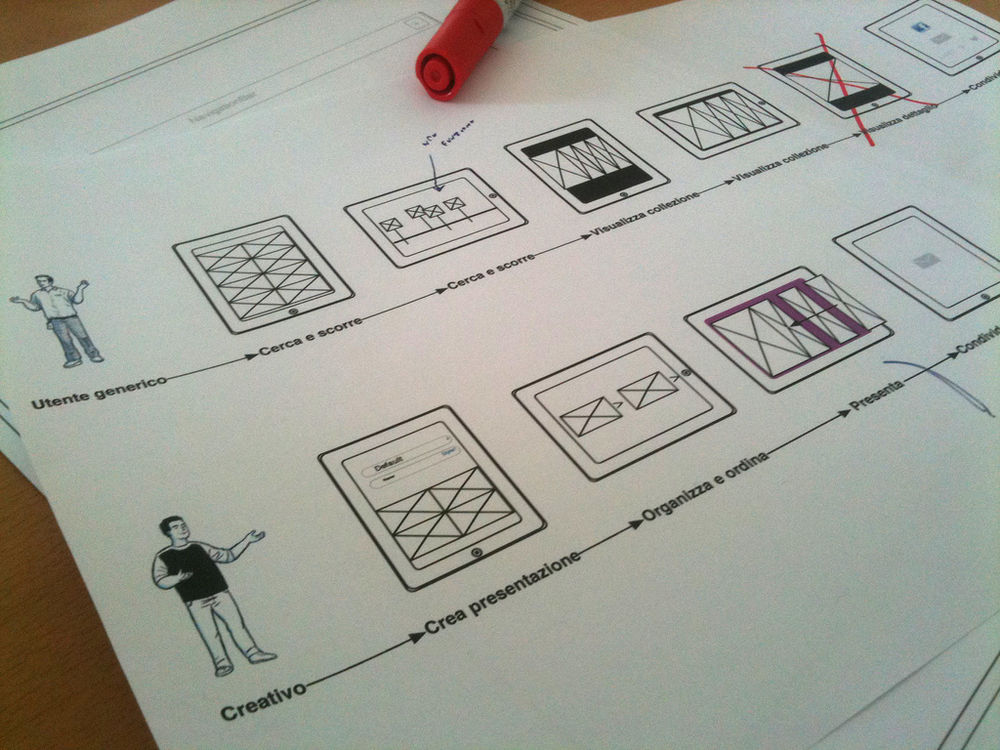
How to create the perfect structure for a UX case study

7 Powerful Steps for Creating the Perfect Freelance CV
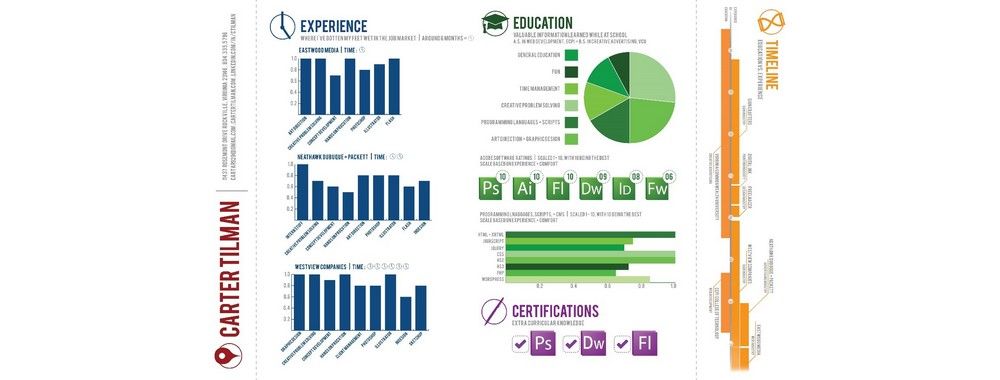
15 Popular Reasons to Become a Freelancer or Entrepreneur

- 4 years ago
The Design Career Map – Learn How to Get Ahead in Your Work

Open Access—Link to us!
We believe in Open Access and the democratization of knowledge . Unfortunately, world-class educational materials such as this page are normally hidden behind paywalls or in expensive textbooks.
If you want this to change , cite this article , link to us, or join us to help us democratize design knowledge !
Privacy Settings
Our digital services use necessary tracking technologies, including third-party cookies, for security, functionality, and to uphold user rights. Optional cookies offer enhanced features, and analytics.
Experience the full potential of our site that remembers your preferences and supports secure sign-in.
Governs the storage of data necessary for maintaining website security, user authentication, and fraud prevention mechanisms.
Enhanced Functionality
Saves your settings and preferences, like your location, for a more personalized experience.
Referral Program
We use cookies to enable our referral program, giving you and your friends discounts.
Error Reporting
We share user ID with Bugsnag and NewRelic to help us track errors and fix issues.
Optimize your experience by allowing us to monitor site usage. You’ll enjoy a smoother, more personalized journey without compromising your privacy.
Analytics Storage
Collects anonymous data on how you navigate and interact, helping us make informed improvements.
Differentiates real visitors from automated bots, ensuring accurate usage data and improving your website experience.
Lets us tailor your digital ads to match your interests, making them more relevant and useful to you.
Advertising Storage
Stores information for better-targeted advertising, enhancing your online ad experience.
Personalization Storage
Permits storing data to personalize content and ads across Google services based on user behavior, enhancing overall user experience.
Advertising Personalization
Allows for content and ad personalization across Google services based on user behavior. This consent enhances user experiences.
Enables personalizing ads based on user data and interactions, allowing for more relevant advertising experiences across Google services.
Receive more relevant advertisements by sharing your interests and behavior with our trusted advertising partners.
Enables better ad targeting and measurement on Meta platforms, making ads you see more relevant.
Allows for improved ad effectiveness and measurement through Meta’s Conversions API, ensuring privacy-compliant data sharing.
LinkedIn Insights
Tracks conversions, retargeting, and web analytics for LinkedIn ad campaigns, enhancing ad relevance and performance.
LinkedIn CAPI
Enhances LinkedIn advertising through server-side event tracking, offering more accurate measurement and personalization.
Google Ads Tag
Tracks ad performance and user engagement, helping deliver ads that are most useful to you.
Share Knowledge, Get Respect!
or copy link
Cite according to academic standards
Simply copy and paste the text below into your bibliographic reference list, onto your blog, or anywhere else. You can also just hyperlink to this article.
New to UX Design? We’re giving you a free ebook!

Download our free ebook The Basics of User Experience Design to learn about core concepts of UX design.
In 9 chapters, we’ll cover: conducting user interviews, design thinking, interaction design, mobile UX design, usability, UX research, and many more!
New to UX Design? We’re Giving You a Free ebook!
Clearing Universities & Courses
Clearing advice.
Recommended Clearing Universities
Popular Course Categories

Course Search & Discover
Start the search for your uni. Filter from hundreds of universities based on your preferences.
Search by Type
Search by region.
Recommended Universities

Northeastern University - London
London (Greater) · 100% Recommended
.jpg)
The University of Law
London (Greater) · 92% Recommended

University of Surrey
South East England · 98% Recommended
Search Open Days
What's new at Uni Compare

Bangor University
Boost your employability with a Computer Science degree!

University of Sussex
Choose Sussex for cutting-edge degrees in Finance, Banking, and Digital Finance.
Ranking Categories
Regional rankings.
More Rankings

Top 100 Universities
Taken from 65,000+ data points from students attending university to help future generations

About our Rankings
Discover university rankings devised from data collected from current students.
Guide Categories
Advice categories, recommended articles, popular statement examples, not sure what to search for, take our quick degree quiz.
Find the ideal uni course for you with our Course Degree Quiz. Get answers in minutes!
Take our full degree quiz
Get more tailored course suggestions with our full Course Degree Quiz and apply with confidence.
PERSONAL STATEMENT EXAMPLE Product Design Personal Statement

Dive into the future of global technological innovation.
Progress online at a pace that fits your lifestyle and equip yourself with sought-after skills. Discover LIBF's range of IT & Computing degrees.

Discover Media and Film degrees at a top 50 university!
Join University of Sunderland on your creative adventure and study Media and Film degrees ranked 11th in the UK (Guardian University Guide 2023)! Explore degrees at your future university now.
Product Design Personal Statement
Building and creating is what sparked my interest in buildings and creating new things so when it came to school I favoured DT and followed this path on through my academic school life up to A-levels. The aspect I most enjoy is the problem solving side of it. Being given a basic problem and having to create a solution, the idea of creating something new that has never been done is exciting. Furthermore you are also helping people by making a product ergonomically usable for them or simply a better way of doing it for existing users. It is good to know what you are doing is making a difference.
I have always been practical and creative so I took my ideas outside of the classroom. As a hobby I BMX so after my first project in DT where I worked with wood in year 10, I was lucky enough to get timber and build myself a half pipe which has lasted many years. This helped me learn how to work with different tools and understand how structures work. This was a good learning curve to broaden my understanding and skills because of this small project I completed it has inspired me to keep on creating. Due to my development of skills and ideas I aim to create more complex projects than the ramp, at the moment I have been inspired by a programme (George Clarks amazing spaces). Since there is a lack of space for quiet undisturbed work area and an area to relax during the summer. From this I have drawn out a few designs for a shed and began to build up a project. It will be built at the back of my garden to be a studio/summer house, with only recycled pallets and other waste materials I can acquire. With all my projects I prefer to incorporate waste or recycled material because of the decline of resource over the years and the high price of premium timber however to make sure the structure is sound I will have to use new nail and screws etc. Otherwise rusty ones would compromise the structure which would be unsafe.
I am currently studying Product design, Geography and business. After looking around Universities on open days and the videos of all the fascinating projects you get to do, Product design was clearly the course I want to take. The way it is set out works well with my working style. It is a subject I thoroughly enjoy, I have been able to demonstrate this over my academic years due to me working well through the course and meeting deadlines.
I believe I am capable to be on the course but admit I have had to work hard on my perspective drawing and computer prototypes designs to get them up to a standard where I can portray my designs ideas across. I taught myself how to use google sketch up and was taught to use Spaceclaim and 2D design. If there is new programmes to learn on the course I will want to learn them because it will aid me in my future of Product design. Also this year I was awarded with a certificate for an outstanding achievement in AS design & technology: 3D product design due to me getting one of the highest results in my year.
Personally I am an outgoing, friendly and honest individual. I believe keeping active is important, I do this with my hobbies such as skiing and going to my local gym. I do this often due to realising that it helps to keep stress levels down so I can work efficiently without distractions. From playing team sports throughout my life I have learnt how to be effective in a team which helped me during my school life and will in the future to fit well into teamed work environment. Therefore due to my experiences this will help me fit into the course well and University life itself.
I look forward to carrying on my product design interest at a higher level as an undergraduate at your university so I can get my degree and carry on a career In Product design.
Recommended Course

Recommended Statements
Submitted by anonymous
Graphic Design Personal Statement
Graphic Design is always around us, and learning how to communicate in a visual manner has inspired me to ...
Submitted by Euan
I would like to study Graphic Communication Design at university as I would like to pursue a career in gra...
Submitted by Kiera
Product Design Engineering Personal Statement
Engineering has made an enormous difference to the world we live in. Throughout recent years technology ha...
Submitted by Megan
Graphic Arts
Becoming a professional designer has been my passion since I was old enough to remember. My inspiration wa...

undergraduate Universities
Undergraduate uni's.

Northeastern Uni
.jpg)
114 courses

Uni of Surrey
750 courses

Uni of East London
575 courses

Uni for Creative Arts
672 courses

Leeds Beckett Uni
454 courses

467 courses

Uni of Sunderland
340 courses

886 courses

Uni of Chester
645 courses

Heriot-Watt Uni
334 courses

Uni of Westminster
503 courses

Uni of Winchester
259 courses

Uni of Roehampton
468 courses

548 courses

Staffordshire Uni
472 courses

Uni of Bradford
390 courses

Cardiff Met Uni
501 courses

Middlesex Uni
634 courses

West London IoT

Uni of Portsmouth
761 courses

Uni of Leicester
432 courses

Uni of Hertfordshire
584 courses

Wrexham Uni
289 courses

Ravensbourne
103 courses

Kingston Uni
617 courses

Swansea Uni
1319 courses

Goldsmiths, UOL
344 courses

Uni of Suffolk
186 courses

Escape Studios

Uni of Reading
685 courses

Coventry Uni
480 courses

Uni of Bedfordshire
656 courses

Queen's Uni
635 courses

Uni of Kent
580 courses
,-Bristol.jpg)
UWE, Bristol
497 courses

Uni of Huddersfield
668 courses

Leeds Arts University

Uni of Essex
1400 courses

Uni of C.Lancashire
798 courses

709 courses

Anglia Ruskin Uni
808 courses

Uni of Brighton
407 courses

Bath Spa Uni
520 courses

Edge Hill Uni
383 courses

Uni of Hull
498 courses

ARU Writtle
104 courses

Nottingham Trent
912 courses

FIND THE IDEAL COURSE FOR YOU
Degree Course Quiz
Find the ideal university course for you in minutes by taking our degree matchmaker quiz today.
Find the latest from Uni Compare

University of Law
Ranked Top 20 amongst English universities in the 2023 National Student Survey!

Cardiff Metropolitan Uni
Ranked as the most sustainable university in Wales (P&P Uni League 2023/24)
- Yekaterinburg
- Novosibirsk
- Vladivostok

- Tours to Russia
- Practicalities
- Russia in Lists
Rusmania • Deep into Russia
Out of the Centre
Savvino-storozhevsky monastery and museum.

Zvenigorod's most famous sight is the Savvino-Storozhevsky Monastery, which was founded in 1398 by the monk Savva from the Troitse-Sergieva Lavra, at the invitation and with the support of Prince Yury Dmitrievich of Zvenigorod. Savva was later canonised as St Sabbas (Savva) of Storozhev. The monastery late flourished under the reign of Tsar Alexis, who chose the monastery as his family church and often went on pilgrimage there and made lots of donations to it. Most of the monastery’s buildings date from this time. The monastery is heavily fortified with thick walls and six towers, the most impressive of which is the Krasny Tower which also serves as the eastern entrance. The monastery was closed in 1918 and only reopened in 1995. In 1998 Patriarch Alexius II took part in a service to return the relics of St Sabbas to the monastery. Today the monastery has the status of a stauropegic monastery, which is second in status to a lavra. In addition to being a working monastery, it also holds the Zvenigorod Historical, Architectural and Art Museum.
Belfry and Neighbouring Churches

Located near the main entrance is the monastery's belfry which is perhaps the calling card of the monastery due to its uniqueness. It was built in the 1650s and the St Sergius of Radonezh’s Church was opened on the middle tier in the mid-17th century, although it was originally dedicated to the Trinity. The belfry's 35-tonne Great Bladgovestny Bell fell in 1941 and was only restored and returned in 2003. Attached to the belfry is a large refectory and the Transfiguration Church, both of which were built on the orders of Tsar Alexis in the 1650s.

To the left of the belfry is another, smaller, refectory which is attached to the Trinity Gate-Church, which was also constructed in the 1650s on the orders of Tsar Alexis who made it his own family church. The church is elaborately decorated with colourful trims and underneath the archway is a beautiful 19th century fresco.
Nativity of Virgin Mary Cathedral

The Nativity of Virgin Mary Cathedral is the oldest building in the monastery and among the oldest buildings in the Moscow Region. It was built between 1404 and 1405 during the lifetime of St Sabbas and using the funds of Prince Yury of Zvenigorod. The white-stone cathedral is a standard four-pillar design with a single golden dome. After the death of St Sabbas he was interred in the cathedral and a new altar dedicated to him was added.

Under the reign of Tsar Alexis the cathedral was decorated with frescoes by Stepan Ryazanets, some of which remain today. Tsar Alexis also presented the cathedral with a five-tier iconostasis, the top row of icons have been preserved.
Tsaritsa's Chambers

The Nativity of Virgin Mary Cathedral is located between the Tsaritsa's Chambers of the left and the Palace of Tsar Alexis on the right. The Tsaritsa's Chambers were built in the mid-17th century for the wife of Tsar Alexey - Tsaritsa Maria Ilinichna Miloskavskaya. The design of the building is influenced by the ancient Russian architectural style. Is prettier than the Tsar's chambers opposite, being red in colour with elaborately decorated window frames and entrance.

At present the Tsaritsa's Chambers houses the Zvenigorod Historical, Architectural and Art Museum. Among its displays is an accurate recreation of the interior of a noble lady's chambers including furniture, decorations and a decorated tiled oven, and an exhibition on the history of Zvenigorod and the monastery.
Palace of Tsar Alexis

The Palace of Tsar Alexis was built in the 1650s and is now one of the best surviving examples of non-religious architecture of that era. It was built especially for Tsar Alexis who often visited the monastery on religious pilgrimages. Its most striking feature is its pretty row of nine chimney spouts which resemble towers.

Plan your next trip to Russia
Ready-to-book tours.
Your holiday in Russia starts here. Choose and book your tour to Russia.
REQUEST A CUSTOMISED TRIP
Looking for something unique? Create the trip of your dreams with the help of our experts.

COMMENTS
7 Jun,2023 Alan Withworth. Find below the User Experience design personal statement that you can use for inspiration. Writing UX design personal statement can be a challenge since there are not many User Experience Design personal statement examples on the blogs to use as a guide when writing your application for university and UCAS.
LinkedIn. Personal website or portfolio. Best Practices for Writing a UX Designer Bio. Showcase your unique value proposition. Emphasize your design philosophy. Highlight your problem-solving approach. Quantify your achievements. Demonstrate your ability to work in a team. Keep your bio concise and engaging.
A strong personal statement for a UX Designer CV seamlessly blends professional achievements with specific UX design skills, clearly demonstrating the candidate's value through measurable outcomes. It stands out by being highly tailored to the UX design field, highlighting expertise in areas like user research, wireframing, prototyping, and ...
Art & Design Personal Statement Example 2. "Life beats down and crushes the soul and art reminds you that you have one" Stella Adler. Where the line of normalcy is shaped differently in the eyes of artists, as everything is relative, there exists the freedom that only artists can create - the space, colour and texture on which that line of ...
Besides crafting a gripping "about me" statement, try to inject a bit of personality into the visual design, too—just like Gloria's colorful hover effect. Key takeaway. ... Highlight your passion and motivation for the UX design, include your personal approaches, and if you have minimal case studies to present, include personal projects
Skills required for your UX designer CV . ... Your CV profile (or personal statement, if you're an entry-level applicant) provides a brief overview of your skills, abilities and suitability for a position. It's ideal for busy recruiters and hiring managers, who don't want to waste time reading unsuitable applications. ...
Start first by breaking down the core company goals and comparing them to your own professional ones. Map them out and demonstrate where you can both align. Demonstrate what you know to be true about the company and what you know to be true about yourself, as well as the value that you can bring to their team. 3.
Personal Statement. ... In turn, I feel that my personal experiences have especially prepared me for a future in product design and user experience. Whenever I approach a design problem, I prioritize perspectives that are often forgotten or overlooked by the general public. For example, when I analyze the user interface on a modern microwave, I ...
I will share my personal statement with you so that you have a example: I have, create and give passion about history and UX to other people. I am dedicated to help and give my sympathy to people ...
Know what you stand for, blog, network, use social media wisely and put your hand up for UX opportunities are the key elements to building a strong personal brand for your UX career. Not exactly groundbreaking stuff, but when applied together and in the right way, can result in a lasting positive impact. What tactics have you used to build up ...
Also, Learn the Top 12 Key UI/UX Design Principles. To give you a clearer picture, here are some UX designer resume examples that encapsulate these principles: Josh Mateo. Design Lead - Netflix. Jack Strachan. Service Service Designer - HM Revenue & Customs. Kevin Mao. Senior UX Designer - Tesla.
The key to personal branding for UX designers. Personal branding has a huge, and I mean HUGE outcome on our ability to land our next source of income, whether that be for landing our next freelance gig, contract position or a full-time job. To highlight how important personal branding is, I want you to imagine that you are a farmer responsible ...
Browse our range of Design personal statement examples. Gain inspiration & make sure you're on the right track when writing your own personal statement. Order Prospectus
UX design helps designers develop technical solutions that enhance the lives of the users. One of Professor Francis' Human-Computer Interaction research motivated me to pursue the UX field. For example, Professor Francis designed a keyboard for paralyzed people to enable them to type with ease.
14. Tell me about yourself. This is a phrase we hear all the time, whether it's being asked in a design interview or in a casual conversation with a designer. It is one of first ways we talk about our experiences and what we are passionate about. For a while, I have been noticing UX design portfolio "about" descriptions and what they say ...
Open With a Great Personal Statement. Your address and contact details belong at the end of a CV. You open the CV with the information that the recruiter really needs to see - your personal statement. This is where you get to tell the recruiter who you are and what you want to do and demonstrate your love for UX. Keep sentences short. Use ...
Your perspective is different from everyone else's and will help you stand out from other UX designers. Developing your personal brand is an excellent way to show people who you are as a designer and why your work is unique. Start by thinking of a few words and core values that you feel accurately sum up your work.
Product Design Personal Statement. Building and creating is what sparked my interest in buildings and creating new things so when it came to school I favoured DT and followed this path on through my academic school life up to A-levels. The aspect I most enjoy is the problem solving side of it. Being given a basic problem and having to create a ...
Elektrostal Heavy Engineering Works, JSC is a designer and manufacturer of equipment for producing seamless hot-rolled, cold-rolled and welded steel materials and metallurgical equipment. MSZ, also known as Elemash, Russia's largest producer of fuel rod assemblies for nuclear power plants, which are exported to many countries in Europe.
Main page; Contents; Current events; Random article; About Wikipedia; Contact us; Donate; Pages for logged out editors learn more
/PRNewswire-FirstCall/ -- Deere & Company (NYSE: DE) officially opened its new manufacturing and parts distribution facility south of Moscow today in...
The Nativity of Virgin Mary Cathedral is the oldest building in the monastery and among the oldest buildings in the Moscow Region. It was built between 1404 and 1405 during the lifetime of St Sabbas and using the funds of Prince Yury of Zvenigorod. The white-stone cathedral is a standard four-pillar design with a single golden dome.